#shichi-kun
Explore tagged Tumblr posts
Text
List of Side Questlines
(last updated 12/27/24!)
This post will be a quick list + summary of the side quests in the game, organized by the character they revolve around. Note that the simple sidequests which start a Confidant, as well as dedicated side stories for characters, aren't included here, and are instead mentioned in the characters' own info posts.
Side quests are distinct from other activities in that, while they take place in the real world, they don't cost an hourglass (i.e., they don't pass time), while still giving rewards for completion of each part. Some may have additional optional activities available to Wonder periodically that do pass time, but are separate from the actual quest line.
Currently Available Quest Lines

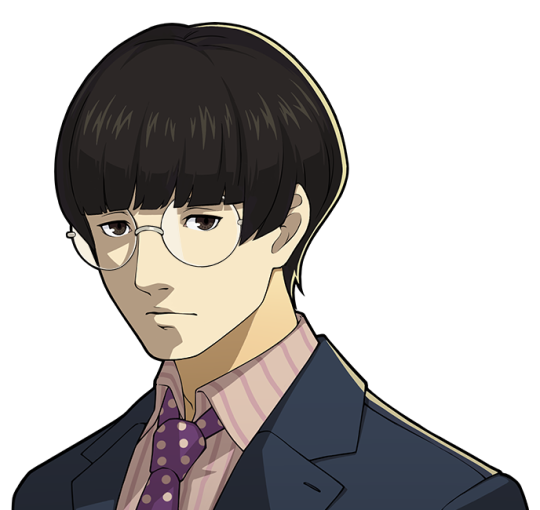
The sports girl (left; name unconfirmed; may be Namie Komatsu) has a side quest revolving around her interest in running. She gets lost easily, so after Wonder helps her out when she gets lost by Kokatsu, she invites him to run with her more often. The side quest also touches on her conflict between her enjoyment of running for fun, versus the added expectations of it now that she's joined her university's team.
The clumsy office worker (right; name unconfirmed; may be Yuta Satou) has a side quest revolving around his struggles at work and with losing things. Wonder initially meets him when he's lost an important USB in Zoshigaya, and Wonder finds it for him. His side quest also often involves another character, who gives him and Wonder advice for dealing with situations in the workplace, and social cues expected there. The player will occasionally have helping him find something pop up as an optional activity that costs an hourglass.
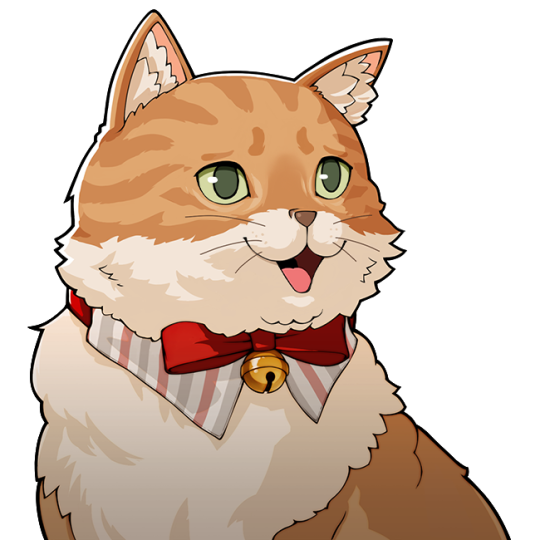

The orange cat (left; name unconfirmed; may be Chata) has a side quest revolving around finding his "hidden treasures", which use the same icon as seed packets. Wonder first meets the cat in Zoshigaya, and sees he's generally treated well by the others in their neighborhood. An old man claims to understand what the cat is "saying", and tells Wonder about the story of how the cat used to rule the various neighborhoods in Tokyo. Wonder gets a part of the story each time he finds the cat's "treasures" in a given neighborhood. The player will occasionally have a smaller treasure hunt pop up as an optional activity that costs an hourglass.
The yakitori vendor (right; name unconfirmed; may be Sumizou) has a side quest revolving around his yakitori stand in Zoshigaya. After a customer suggests it, he tries opening delivery orders, and has Wonder go around Tokyo to deliver them, often learning about the delivery recipients along the way. He's always very happy that people are able to enjoy his yakitori without needing to come directly to his stand.

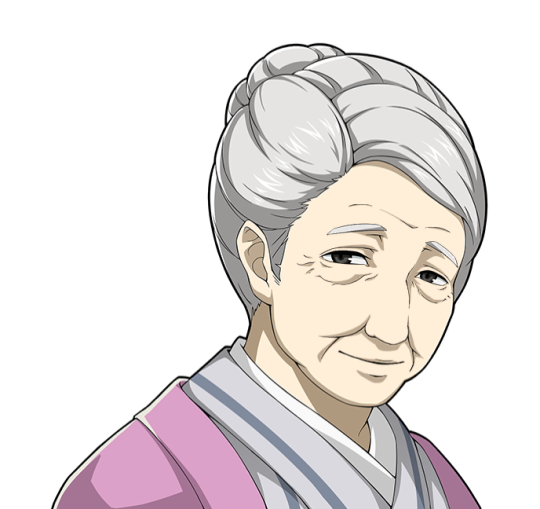
Anderson's (left) side quest revolves around his gym workouts, but also his unluckiness in love. Wonder helps him out with figuring out what to say on dates, though he also at least in one instance discovers the girl Anderson's meeting is just leading him on. Anderson is very solely focused on muscles, health, and generally aspects that relate to his workout routine, which is part of why he struggles.
The elderly calligraphy teacher (right; tagged as "calligraphy lady"; name unconfirmed, but may be Fumiyo Tosabayashi) has a side quest that revolves around mysterious anonymous letters with brief poems on them that she's been receiving. She suspects they're from a member of her old club in high school, but has to narrow down who specifically. She also teaches Wonder about aspects of traditional Japanese culture to help explain the poems. Notably, the owner of the secondhand shop in Yongen-Jaya is one of the old club members.

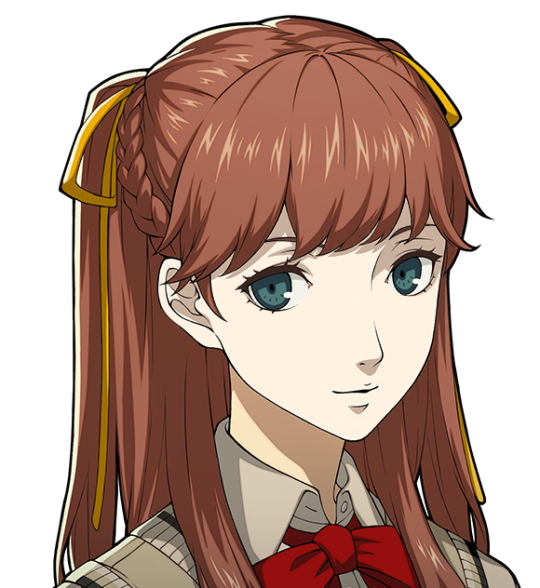
The photographer (left; name unconfirmed; may be Rikuto Shimizu) has a side quest revolving around his series of photos focused on the idea of "change". Wonder catches his eye because he noticed Wonder has changed recently, and he takes some pictures of Wonder as well as asking for his opinion on some of his photos. A problem does arise when he unknowingly takes a picture of an idol violating her contract, then accidentally uploads it to his portfolio while going through his pictures, leading to his account getting taken down to avoid a scandal. The player will occasionally have taking photos with him pop up as an optional activity that costs an hourglass.
The music club girl (right; tagged as "music girl"; name unconfirmed, but may be Ritsuka Takanashi) is a member of Kokatsu's music club, and her side quest revolves around helping keep the group together as they work towards becoming a band that can compete in a competition. Wonder is first recruited because they need one more member, and can't find anyone to join, until she runs into him in the hallway. She's usually relatively calm and level-headed, but occasionally has outbursts of excitement where she can't control her volume. The player will often have the rhythm minigame where Wonder practices with the club pop up as an optional activity that costs an hourglass.


The soccer club boy (left; tagged as "soccer boy"; name unconfirmed, but may be Yota Kurosawa) is a member of Kokatsu's soccer team, and his side quest revolves around practicing soccer. Wonder is first recruited because he's struggling to find enough people to keep their soccer team going, due to other students repeatedly dropping out for losing motivation. During his quest line, it's a recurring problem that the rest of the team has no interest or enthusiasm suddenly, so he tries to find ways to keep them going. The player will often have the soccer minigame where Wonder practices against their goalie pop up as an optional activity that costs an hourglass.
The coffee lady (right; name unconfirmed; may be Ena Kageyama) is a coffee barista, who decides to finally take the step to open her own coffee shop after wanting to do so for a while. Wonder helps her out with a troublesome customer at her old job, then helps her scout locations for her shop. She appreciates his point of view from the perspective of a customer.


John Harris (left) is a man from the United States, who still struggles with some aspects of the Japanese language, as well as adjusting to the time difference. He tends to walk around at night when he can't sleep. Wonder knows English well enough to help him out, and assist in communication.
The tour guide (right; name unconfirmed, but may be "Ayumi Ogata") is a woman working in Kichijoji giving tours of the area, though she has a tendency to spin her own stories about locations in an attempt to make the tour more fun, and the locations more memorable, even if the stories aren't exactly true. She appreciates that Wonder understands what she's going for, and asks him to help keep her from taking her stories too far.


Kazuhiko Tsuda (left) is a younger boy who seems to think of himself as something of a detective, and likes to help people out with his reasoning. He thinks that Wonder's viewpoint is useful, and also that he can learn something from him, so he asks Wonder to assist him.
The cat cultist (right; name unconfirmed, but may be "Neiko Takahashi") is the "saint" of a group called the NK Association, which worships a stray cat in Kichijoji. She recruits Wonder to their group, and her quests revolve around initiating him and his duties.

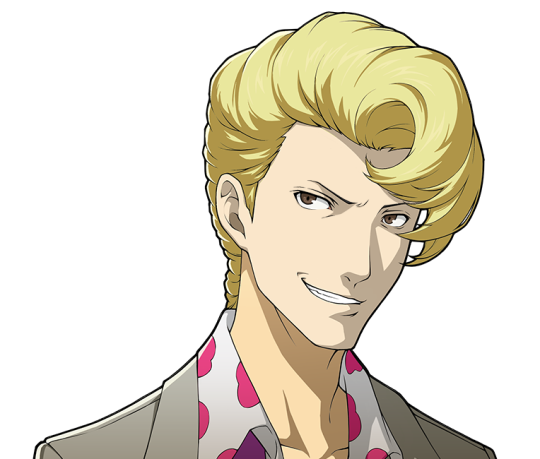

The unlucky businessman (left; name unconfirmed, but may be "Masataka Takeda") runs a company that's at risk of going bankrupt, and is trying to pull it back out of the red, but his bad luck keeps getting in the way. Still, he stays optimistic, and appreciates Wonder's help.
The blonde guy (middle; name unconfirmed, but may be "Tetsunojo Shishida") is a man in Shinjuku.
Shinta Ezaki (right) is a researcher who works in Akihabara, and was first introduced in the Akihabara puzzle event. His side quest will be added in Version 3.2.1.
Other Side Quests
These quest lines were present in one or more beta tests, or have otherwise been indicated to exist, but are not currently available in any form in the official release.



The girl on the left (tagged as "animals girl"; name unconfirmed but may be Hiyori Koide) is attempting to gather donations for some kind of animal rights or something otherwise animal-related, and travels around Tokyo with Wonder doing so.
Shichi-kun, the Shibuya mascot in the middle, welcomes people to Shibuya and has a lot of information about the area, though it seemed he was in some kind of trouble. What was originally his side quest may have become Runa Dogenzaka's Confidant, though this is currently unclear.
Saki Shirai, on the right, works for a Tokyo newspaper. She was first introduced in the Akihabara puzzle event, which confirmed her side quest will be added to the game in the future.
#character info#open beta#sports girl#office worker#orange cat#yakitori vendor#anderson#calligraphy lady#photographer#music girl#soccer boy#coffee lady#kazuhiko tsuda#animals girl#blonde guy#shichi-kun#tour guide#john harris#cat cultist#unlucky businessman#shinta ezaki#saki shirai
28 notes
·
View notes
Note
If you’re still looking for a prompt to write, I’d love to read your take on Kalego finding out iruma is human. Do you think he already knows? If not, what event would initiate that conversation and what would happen after the fact. I’d love to see Balam respond to the whole thing too (he’s the best & I’m not sure how Kalego would feel about him having known about it the whole time).
Also, I remember a post about iruma giving teachers cards for mother’s/father’s day and I would absolutely adore reading a fic about that. Iruma deserves the world 😭
Anyway, just wanted to say I love your writing and hope you have a great weekend!
Anon thank you, and i agree iruma does deserve the world! Kalego here doesn't know iruma's secret, but that’s about to change >:3
He's wHAT?!
"-and then he had the audacity to look me in the eye, and ask me what having wings feel like? He then panicked and kept saying he meant feather wings but then he just ran out of my offiice! I swear sometimes it's like he's not even a demon!" Kalego let out a sigh before drinking the tea in his hand.
He really enjoys Friday evenings with Shichirou, the only demon he's ever allowed himself to be so close to. His younger self was so cagey about this, but now Kalego not only appreciates the deep relationship he developed with Shichi, he also prides himself in the fact that he knows Shichirou better than most
Which is how he knows that Shichirou is hiding something.
"Hmm, does the patterns on your office's floor intrigue you that much, Shichi?" The demon in question jumps, almost spilling his tea all over him
"Wh-what?! No I'm just! mulling over how weird this interaction with iruma is!" He says, which is partially true. Shichirou was most certainly thinking about something in Kalego’s rant
Thinking about how to steer Kalego’s attention from it
"Ma-maybe I should answer his question! After all I do have feathers so-"
"What is it?" And Shichirou knows what Kalego is talking about. He's never been good at lying to Kalego. Everyone else? As easy as breathing, but to Kalego? Never did he try hiding something that Kalego didn't find out about
So he stays silent, averting Kalego’s eyes because he knows if he looked into them he won't be staying silent much longer
But it's just so hard when Kalego keeps staring at him! He could literally feel the suspicious, calculating gaze Kalego is throwing him!
"..is it about Iruma’s wings?" He asks. It is the last thing he talked about before Shichirou grew quiet
"Ah, y-yes! Something like that" ah, so it’s not about his wings, but his wings are related?
Kalego kept staring at Shichirou, watching as his hands fidgeted with the cup of tea he's holding. What else did he say? What could've made Shichirou grow so quiet-!
"...Shichirou," his hands fidgeted faster as he looked into Kalego’s eyes. Kalego could see the sweat pouring down as he opened his mouth to confirm his suspicion
"Is Iruma not a demon?" Shichi flinched, letting go of the cup in his surprise.
So, Iruma is not a demon. That was a headache
A thought popped into his mind that made Kalego feel so so tired. But that's crazy! There's no way the chairman would- oh who's he kidding, the chairman absolutely would
"Shichirou is the chairman housing a deity?" He asked, exasperation written into his very soul from the question alone
"Wh-what?! Come on, the chairman isn't that crazy!"
"But he is housing something that's not demon" and Shichi didn't deny that
"Shichi, what is Iruma?"
"..it's not my secret to share" and that broke the last of Kalego’s patience. This isn’t the first time Shichi said those words, and usually Kalego would respect that response and would steer things away from whatever secret Shichi is keeping
But not this time. Not when it comes to his students, not when it comes to Iruma
"Shichirou, Iruma is my kid" he said with so many emotions he didn't know he'd feel, and by the look on Shichi's face, neither did he
"My job as his teacher is to provide him with the right tools to succeed. My job as his familiar is to protect him from anything that might pose as a danger to him. This information that you're withholding from me is detrimental to how much I can do for him
"Shichi, I understand that you want to protect his secret, but there are some things that I need to know. The nature of Iruma is one of those things. Please tell me so I know how to help him survive" Shichirou looked into Kalego’s eyes and
He's right. Kalego is his teacher and his familiar. He's the one who spends the most time with Iruma, and there’s only so much Shichirou could do without his fre-friend's help
But
"You will not hurt him" confusion appeared on Kalego’s face before it turned serious again
"I won't"
This is a child's life they're talking about
"You will not demand he leaves"
This is not a secret to be shared with any demon
"I won't"
And Shichi truly trusted Kalego with his life
"Swear on your family's name"
But he doesn’t trust the Naberius clan
"I swear on my family's name, on the name Naberius, that I shall not put Iruma Suzuki in harm's path, nor shall I banish him for his nature"
Kalego didn't understand why Shichi would go to such lengths, but he trusts Shichi. He trusts that Shichi won't make him swear on something small.
Whatever Iruma’s origin may be, Kalego swears that he won't discriminate against him in any way, shape or form, even if he turns out to be of holy origins
Shichirou took a deep breath in, content that his friend did not question his demands and followed through
"Well, not even Iruma’s closest companions know of this-although he does plan on telling them- but Iruma is actually a human" he laid back as he said it, and watched Kalego’s face for anything that might appear on it
He's ready for anything. Hatred, disgust, acceptance, absolute indifference, but the reaction he got is something that made him truly relax. There's no way Kalego will do anything stupid when he gets that look on him
The look of absolute exasperation. A look that just screams
"Of course he's a human. Of fucking course" yep, that's a Kalego who still likes Iruma like his own son
Kalego let out a deep, bone shattering sigh before getting up
"Where are you going?" Shichirou said as he poured himself more tea. This conversation was nerve-wracking, but he's glad it's over now
"Iruma stays late at school to help the gardeners. I need to have a talk with him"
"Mhmm, should I wait for you or head home first?"
"Wait. I'm just gonna inform him that I know, anything else will be after the weekend I am too tired to deal with this train wreck now" Shichirou hummed as he gulped down the tea, completely regretting his choice because this tea is cold
Kalego stopped at the doorway. There is something that's bothering him about this conversation, but he's not sure if now's the right time
But, when else will he get the chance to ask?
"Why...did you not tell me from the start? That it's Iruma’s secret?"
"Because you respect me too much, Kalego" he put down the cup of cold tea, intent on making a new batch once Kalego goes out the door
"You respect me too much, and you would have respected my wishes. You wouldn't have brought this up again, and even if you figured it out you wouldn't have come to me to confirm whether what you believe is true. You would've simply let it go because I asked you to
"But I wasn't sure whether I wanted to keep this a secret from you or not. I knew that if I told you that, I'd never get another opening to tell you. And I was afraid that you'd find out when it's too late"
Kalego, content with the answer he got, continued on his way to the sakura garden. Shichirou got up and took his teapot to the counter to make more hot tea.
He was also afraid.
Afraid that he made the wrong choice, telling Kalego instead of letting him ask Iruma himself. Afraid that Iruma would hate him for sharing his secret. Afraid that he'll go back to being the creepy teacher that no student likes.
but there's no need to guilt Kalego like that now. This is something that Shichirou will have to talk with Iruma about later, and Shichirou is not going to trouble his friend just because he was worried about his kid
.
.
.
Wait, did Kalego say that Iruma’s his kid?
------------------------------------------------------------------------------
Bonus/another way i wanted to try
Balam:he's a human
Kalego:...
Kalego: shichi he's trolling you
Balam:..you really think iruma is capable of trolling people?
Kalego: my mistake
Kalego: shichi the class is making him troll you
Balam: no!!
Kalego *going to the royal one classroom*: I'm gonna make them train so hard they'll be wishing they volunteered to be marbas's test subjects
Balam *visibly distressed*: nO!!!!!!
Welp, this was fun! Time to go finish that one fic i started when i was procrastinating on that other fic
@floraroxy im not sure whether you wer joking but guess what!
#god writing is so hard when you know a word doesn't exist in someone's vocabulary#like how do i go around that?#how come the one time i know the exact word i wanna use#i can't use it#mairimashita! iruma kun#welcome to demon school iruma kun#mairimashita iruma kun#m!ik#naberius kalego#balam shichirou#also yes his nockname is shichi#his given name is too long and writing it sounds like he's being scolded
112 notes
·
View notes
Text
Shoujosei (Shoujo and Josei) Anime to look forward to in 2024
With the return of Kimi no Todoke after 12 years, I welcome all to the Shoujo renaissance! Let’s roll on the hype train! (MyAnimeList links are in titles)
Winter Anime Season (January - March)
Momochi-san Chi no Ayakashi Ouji Airs January 6th
Loop 7-kaime no Akuyaku Reijou wa, Moto Tekikoku de Jiyuu Kimama na Hanayome Seikatsu wo Mankitsu suru Airs January 7th
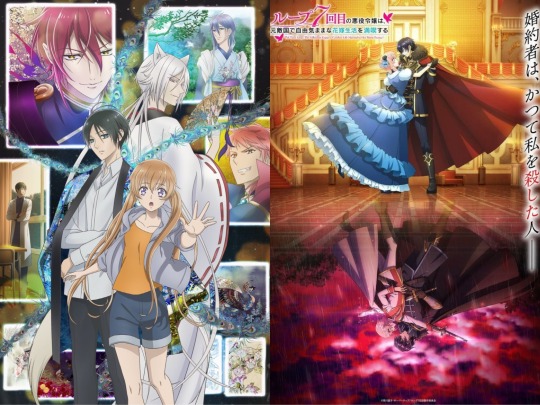
Isekai de Mofumofu Nadenade suru Tame ni Ganbattemasu Airs January 1st
Kyuujitsu no Warumono-san Airs January 8th

Yubisaki to Renren Airs January 6th
Watashi no Shiawase na Kekkon: Watashi no Shiawase na Katachi Airs March 15th

Gekai Elise Airs January 10th
Akuyaku Reijou Level 99: Watashi wa Ura-Boss desu ga Maou dewa Arimasen Airs January 9th

30-sai made Doutei da to Mahou Tsukai ni Nareru Rashii Airs January 11th
Given movie 2:Hiiragi Mix Airs January 27th


Murai no Koi Airs February 4th

Wonderful Precure Airs February 4th
Ensemble Stars!! Tsuioku Selection Checkmate Airs March 10th
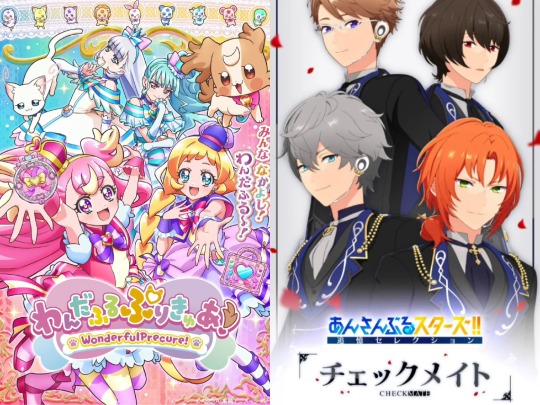
Spring Anime Season (April - June)
Hananoi-kun to Koi no Yamai Airs April 4th
Vampire Dormitory Airs April 7th

Touken Ranbu Kyoden Moyuru Honnouji Airs April 2nd
Rabbits Kingdom the Movie Airs June 14th
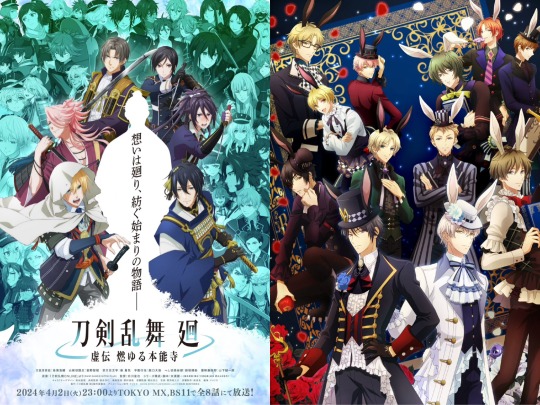
Tonari no Youkai-san Airs April 7th
Himitsu no AiPri Airs April 7th


Tadaima, Okaeri Airs April 9th
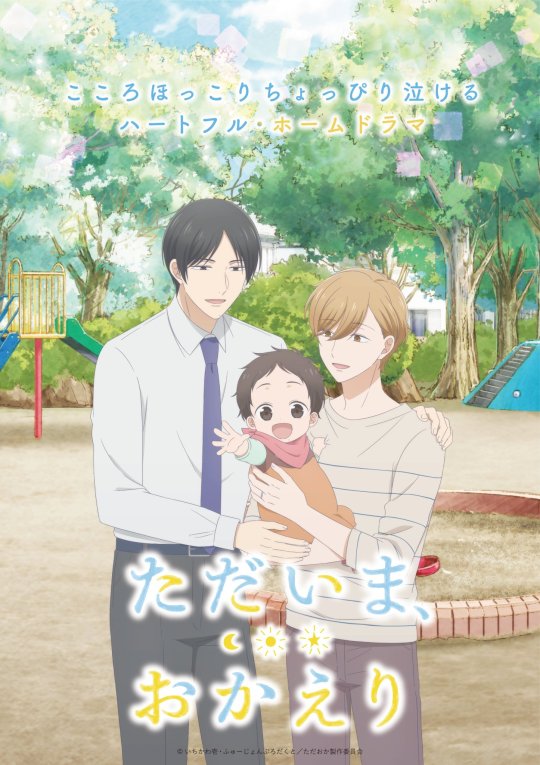
Summer Anime Season (July-September)
Senpai wa Otokonoko Airs July 5th
Madougushi Dahlia wa Utsumukanai: Kyou kara Jiyuu na Shokunin Life Airs July 6th
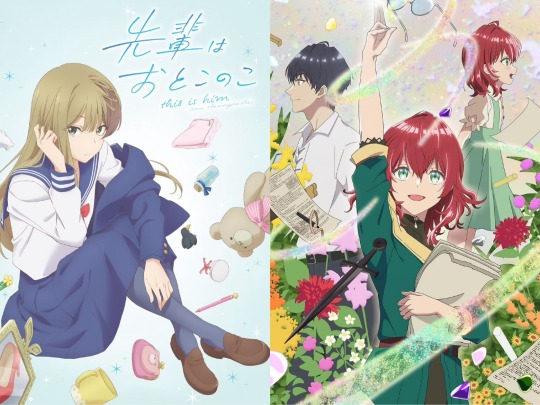
Tasogare Out Focus Airs July 7th
SutoPuri Movie: Hajimari no Monogatari Airs July 19th


Kimi ni Todoke 3rd Season Airs August 1st
Yeosin Gangnim Airs August 7th

King of Prism: Dramatic Prism 1 Airs August 16th
Given movie 3: Umi e Airs September 20th


Fall Anime Season (October - December)
Hoshifuru Oukoku no Nina Airs in October
Rekishi ni Nokoru Akujo ni Naru zo: Akuyaku Reijou ni Naru hodo Ouji no Dekiai wa Kasoku suru you desu! Airs in October
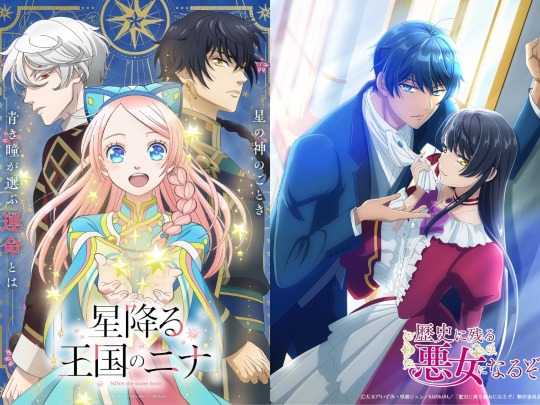
Natsume Yuujinchou Shichi Airs in October
Goukon ni Ittara Onna ga Inakatta Hanashi Airs in October
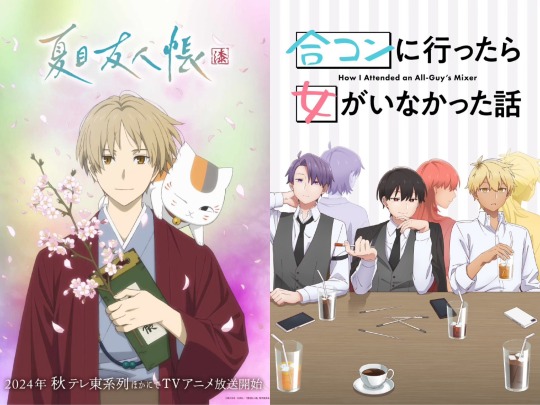
Acro Trip Airs in October
Haigakura Airs in October
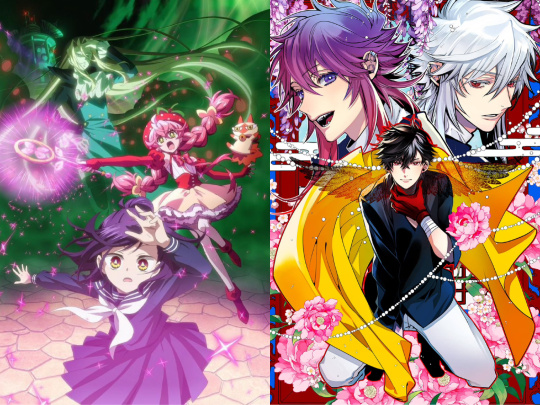
Yarinaoshi Reijou wa Ryuutei Heika wo Kouryakuchuu Airs in October
Taishou Itsuwari Bridal: Migawari Hanayome to Gunpuku no Mouai Airs October 7th


Tono to Ino Airs October 10th
Hyakushou Kizoku 2nd Season Airs October 4th


30-sai made Doutei da to Mahou Tsukai ni Nareru Rashii Movie Airs December 13th

#anime#anime 2024#shojo anime#josei anime#shoujo anime#Shoujosei#shojosei anime#anime adaptation#Momochi-san Chi no Ayakashi Ouji#loop 7 kaime no akuyaku reijou wa#yubisaki to renren#isekai de mofumofu nadenade suru tame ni ganbattemasu.#mr villain's day off#Doctor Elise: The Royal Lady with the Lamp#my happy marriage#watashi no shiawase na kekkon#Hananoi-kun to Koi no Yamai#vampire dormitory#wonderful precure#mahoutsukai precure#Acro Trip#Nina of the Starry Kingdom#kimi ni todoke#Natsume Yuujinchou#akuyaku reijou level 99: watashi wa ura boss desu ga maou de wa arimasen#Yarinaoshi Reijou wa Ryuutei Heika wo Kouryakuchuu#puella magi madoka magica
80 notes
·
View notes
Text
I need help!
Hi guys, I'm not sure anyone would answer, but I've got question, so... I'm not risking anything. I've just logged to ao3, it's supposed to be the biggest base of fanfics and... I'm disappointed. I mean, I knew that the less popular fandom, the less ffs I'll find - but still. Does any of you know (or write) a ff about Yamato nadeshiko Shichi Henge (the Wallflower)?
I'll probably read some other anime ffs on ao3, but it terribly lacks good old stuff. And I miss Sunako and Hiroshi-kun very much.
o(〒﹏〒)o
If you know nothing about the Wallflower, but you somehowe saw my post and your good souls want to help me, you can also recommend me any good stories from other fandoms like Vampire Knight, Shiki, Kuroshitsuji or Elfen Lied. Thanks!
3 notes
·
View notes
Text
The Chanoyu Hyaku-shu [茶湯百首], Part IV: Poem 84.

〽 Futaoki ni mitsu-ashi ara-ba hitotsu-ashi mae ni atsukau to kokoro-ete oke
[蓋置に三ツ足あらば一ツ足 前に使うと心得て置け].
“If a futaoki has three feet, [you] should know, when handling it, that one foot should [always] be in front when placing it.”

The oldest documentary evidence¹ showing the arrangement of the utensils that are used when serving tea, whether on the daisu or on the o-chanoyu-dana, consistently show a futaoki that was called the kakure-ka [隱れ家]².

Today this futaoki is known as the gotoku [��德]³. And, as seen in the above drawing (which is a detail from one of Nōami’s sketches), the kakure-ka / gotoku was always supposed to be handled with one foot toward the front -- whether on display, or when being used during the temae (this is why, in Nōami’s sketch, the kakure-ka was made disproportionately large -- to give emphasis to the way it was to be oriented).

In addition to the gotoku, two of the other futaoki included among the futaoki shichi-shu [蓋置七種]⁴ have three feet: the mitsu-ningyō [三つ人形]⁵ (sometimes referred to as the mikkan-jin [三閑人]⁶), and the mitsuba [三つ葉]⁷. The three are shown above.

All three of these futaoki, as well as any others that have three feet, should always be handled so that one foot is in front -- in other words, this means that one foot should always be positioned so that it faces or points toward the host, whether the futaoki is displayed (or being used) on the ji-ita of the daisu (above, based on Rikyū’s arrangement, and, below, in consideration of the other alternatives⁸)...

...or when the futaoki has been placed on the mat itself (as shown below⁹).

In all of these examples, one leg always is in front, oriented toward the host’s seat¹⁰. (As in Nōami’s sketch, the size of the futaoki, as well as the locations of the legs, have been emphasized in the interests of clarity.)

In the case of poem 84, while Jōō’s version of the poem appears to be different, it is simply saying the same thing from a different perspective:
〽 futaoki ni mitsu-ashi araba ashi futatsu mukō ni nasu to kokoro-ete oke
[蓋置に三ツ足あらばあしふたつ むかふになすと心得ておけ].
“If the futaoki has three feet, [you] should know that two of the feet should be on the far side when it is put down.”

Whether we orient this kind of futaoki so that one foot is in the front, or two are on the far side, the result will be exactly the same.
_________________________
¹Such as the Kun-dai kan sa-u chō-ki [君臺觀左右帳記], from the 1884 facsimile edition of which the detail of the sketch illustrating the orientation of the kakure-ka was taken.
²Kakure-ka [隱れ家] means a retreat, a place to conceal oneself from the world. The reason for this name is because the ring with three legs resembles a fence erected around a hermitage, to keep outsiders away. (This, by the way, tells us that the original way to display this futaoki was with the ring uppermost. Turning it over is a deviant practice that appeared during the Edo period, when the original usage -- along with the the original name -- had been forgotten.)

This object was originally made to support the saucer of oil in a ya-gaku [夜學]* (a ceramic nightlight). ___________ *In China and Korea, nightlights were made of ceramic (to prevent fires), with a cutout decoration around the sides to let the light out.
Ya-gaku [夜學] literally means “studying at night” -- referring to the fact that artificial lighting provided by lamps of this sort allowed one to read “even on a moonless night.”
³The word gotoku [五德] means “five virtues.” In this context at least, the name was coined by Sen-no-Dōan, as a sort of humorous play on the word jittoku [十德] (”ten virtues”) -- which was the name of a monk’s outer robe (resembling a short kimono, it usually reached to the mid-calf, and was sewn from ten pieces of black gauze, hence the name).
Originally the gotoku (when used to support the kama in the furo, and the ro), which was inspired by the little stand that elevated the saucer of oil in a nightlight above the floor of the lamp (which allows the lamp to give off more light), was used with the ring uppermost. A kiri-kake-gama [切掛け釜] or ha-gama [羽釜] (this is the kind seen below) was rested on the ring the same way it was rested on the rim of a kimen-buro [鬼面風爐] or Chōsen-buro [朝鮮風爐]. When placed in a ceramic mayu-buro [眉風爐] (shown below), the ring was hidden from view by the “eyebrow” (the arch above the hi-mado).

After the Rikyū’s family declared bankruptcy, Rikyū’s (as the fourth son of the house) and his family were particularly hard off. And though Jōō had sent him to Korea with the intention that he back chawan and other pieces that he could sell to rebuild his fortune (he left for the continent shortly after Dōan’s birth), he stayed there much longer than planned, and it was many years after he returned before he could restore his house to anything resembling its former prosperity.
On a certain occasion, in 1575 or 1576, the teenaged Dōan found a mayu-buro in the local dump that had been thrown away because the “eyebrow” had been broken. Dōan took the furo home and cut away the remainder of the mayu, extending the left and right sides of the himado straight up to the rim. Because the ring of the gotoku ran across the now-open space (and looked as if it would inhibit the host’s actions during the sumi-temae), Dōan cut the front section of the ring off as well, so the hi-mado was wholly unobstructed. The two remaining sections of the ring, plus the three legs, equaled five, and this is what inspired the name “five virtues” (gotoku). Meanwhile, this kind of furo became known as the Dōan-buro [道安風爐].
The name gotoku came to be applied to any sort of ka-joku [火卓]†, regardless of the number of legs or whether the ring was cut or remained intact, and this is still so today.
The gotoku was not used upside-down (so that the kama rested on top of the three legs, rather than on the ring) until circa 1583, after Rikyū created the small unryū-gama for use with the (cracked) large Temmyō kimen-buro that had belonged to Nobunaga‡. ___________ *A jittoku was also worn by chajin when participating in chanoyu.
†The word ka-joku [火卓] is one old name for this kind of metal stand that was used to support the kama above the fire.
‡This was the same large iron kimen-buro that Yoshimasa had placed on the naga-ita when serving tea during his brief second retirement (1590 ~ 1591). It became cracked when Mori Ranmaru threw it against the wall after Nobunaga’s seppuku in order to burn down the shoin so that Nobunaga’s head could not be taken and paraded.
Rikyū turned the gotoku upside-down because if it was used with the ring above, the ring would have prevented the hot air from rising and heating the kama properly.
⁴Futaoki shichi-shu [蓋置七種] were the seven “classical” futaoki that had been treasured since the time of Yoshimasa.

In addition to the kakure-ka / gotoku, mitsu-ningyō, and mitsuba, these included the hoya [ホヤ] (the original hoya was a Byzantine cloissoné reliquary), the ikkan-jin [一閑人] (made as a paperweight, part of a set of matching writing implements),the sazae [榮螺] (originally a natural horned turban shell), and the kani [蟹] (another paperweight, in this case shaped like a squatting crab).
⁵Mitsu-ningyō [三つ人形] means three dolls.
Since the Edo period the Japanese have dressed the three dolls differently -- with one attired in Chinese garb, one in Korean traditional hanbok, and the third (traditionally used as the front) in a kimono. However, in the case of the original Chinese mitsu-ningyō*, all three were dressed the same -- as Chinese children.

In China these objects were made as little tripids, to elevate the saucer of oil above the floor of a nightlight. ___________ *Chinese pieces of this type are always made of pottery. Those from the Song dynasty are usually celadon, while those fired after 1370 are made of a low-fired green-glazed pottery (as seen above), similar to Raku-yaki. This same kind of pottery was also used to make the lampshade and base for the nightlight as well (this is the reason why the Japanese tomoshibi [燈火], oil lamps, and shoku-dai [燭臺], candle sticks, that are used in chanoyu came to be glazed green beginning in the second half of the seventeenth century, when this sort of ware, and the green glaze technology, were imported from the continent, and then adopted by the Raku family).
⁶Mikkan-jin [三閑人] means “three men of leisure.” This name contrasts with ikkan-jin [一閑人] -- “one man of leisure” -- used as the name for the futaoki that represents a little man gazing into a well (see footnote 4, above).
The expression kan-jin [閑人], which can also be pronounced hima-jin and muda-bito, means a person with a lot of free time on their hands, a man of leisure -- but also (particularly muda-bito) an idler, a loafer, a wastrel. It thus has a rather humorous nuance (which may be why some of the schools prefer to use this name, while others are definitely repulsed by it).
⁷Mitsuba [三つ葉] means trefoil, a variety of plant with trifoliolate leaves. The mitsuba was originally made as the rest for the bronze spoon-like ladle that was used to stir, and then dip out, a portion of makkoli [막걸리] (a type of shira-zake [白酒], unfiltered sake), as an offering during Korean Ancestor Worship rites (je-sa [제사 = 祭祀]).

During these rituals, each member of the extended family approaches the Ancestor Altar, bows, and offers a ceremonial cup of makkoli to the Ancestral Spirits after passing the cup through the smoke of an incense burner. Afterward the cup is emptied into a special receptacle (the Korean bronze and sawari [サワリ = 四分一] koboshi were originally made for this purpose), before being refilled for the next person to use.
One end of the mitsuba is larger than the other. In chanoyu, the mitsuba is displayed with the larger side uppermost; but during the temae, it is turned over so that the larger side (which is more stable) faces downward.
⁸In situations when the koboshi was not displayed on the ji-ita, then the futaoki was usually placed in the middle of the arrangement, centered between the body of the furo and the mizusashi.
And while Rikyū preferred for the futaoki to be placed on the left side of the ji-ita, between the furo and the leg of the daisu, the rule was that the futaoki should be displayed on the side of the ji-ita closest to the katte.
⁹While the usual way was to place the futaoki on the left side of the mat, near the furo (during the temae), there were certain cases (such as when the futaoki was a meibutsu -- especially one of the original shichi-shu described above) when it would be placed on the right side of the mat, as shown in the right sketch.
¹⁰If used in the wabi setting, a futaoki with three feet would be used according to the same rules; though, in fact, the take-wa [竹わ = 竹輪]* -- a futaoki made from a short length of bamboo -- was always (and remains) the preferred futaoki for the wabi setting. ___________ *This kind of futaoki is also referred to as a hikkiri [引切].

Take-wa means a bamboo ring: Jōō’s original bamboo futaoki did not include a node (as can be seen in the copy of Jōō’s take-wa made by Rikyū, on the left), while Rikyū’s own take-wa had a node located just above the middle. (Sōtan was the one who began to popularize the custom of using a hikkiri with a node near the top with the furo, while one with the node just above the middle was to be used with the ro.)
Also, Rikyū held that the side with “something different” -- whether a natural crack or dimple, or a shoot-bud, or a difference in color or patterning -- should be used as the front. This idea probably was inspired by the rule, articulated in this poem, that one foot should always be used as the front.
==============================================
❖ Appendix: Regarding the Futaoki.
Line 251 in the Chanoyu san-byak’ka jō [茶湯三百箇條] reads futaoki ni tsuku hishaku no koto [蓋置きにつく柄杓の事], which means “the matter of resting the hishaku on the futaoki.”

The photo shows two take-futaoki [竹蓋置], also known as hikkiri [引切]¹¹. Today the kind shown on the left is used with the ro, while that on the right is used with the furo. However, as mentioned above, this rule was articulated by Sōtan; Rikyū’s take-wa [竹〇 = 竹輪], as the bamboo futaoki was known in his day, were usually of the left sort, with the node located just above the middle, while Jōō’s take-wa lacked a node entirely¹².
The futaoki, regardless of the material from which it was made, should always have a depression of some kind on the top¹³. This depression is called the hi [樋]¹⁴. According to Rikyū, when resting the hishaku on the futaoki, the corner of the cup of the hishaku is fitted into the hi (as shown in the drawing, below), and then the handle is gently lowered to the mat (as if attached to the futaoki by a hinge). This was the secret of the way to perform this action.

To strike the cup against the futaoki with an audible clack, or release the handle several sun above the mat, allowing it to bounce on the mat (as many modern schools teach) were considered to be a serious mistakes by Rikyū -- because these actions could cause the handle to become loose¹⁵, meaning it might leak during the temae (which would damage the host’s reputation).
While bamboo futaoki are considered extremely wabi objects today, it is important to recognize that Rikyū used them frequently, even displaying them on the daisu and the nagaita from time to time.
_________________________
¹¹Hikkiri [引切] literally means to chop wood, cut timber. It is said to be an onomatopoeia for the sound of an axe or knife slashing through wood or bamboo.
In theory, at least, the bamboo futaoki was supposed to be made by slashing through a bamboo clum with a sword; so this term for a futaoki made of bamboo first appeared (during the Edo period) in the samurai tea culture.
¹²Tsurube, mentsū, take-futaoki, kono mi-iro, Jōō-gonomi dasaretari [釣瓶・面桶・竹蓋置、此の三色、紹鷗好み出されたり]. This comment, from the Yama-no-ue Sōji ki [山上宗二記] can be translated “the tsurube, the mentsū, and the bamboo futaoki, these three were preferred by Jōō.”
While Jōō is generally credited today with creating the take-futaoki*, it would be more accurate to say that he was the one responsible for introducing its use into the tea room. Lid rests made from bamboo had been used in the kitchen for centuries. The same can be said for the tsurube (which, from ancient times, had been the way water was carried from the well), and the mentsū (which came in two sizes, both of which were bathing utensils: the small one used to rinse the body before entering the bath tub, while the larger one was used when washing the face).
Jōō, in his latter years†, preferred these simple, everyday, objects over the specially-made, costly imported treasures that were preferentially used with the daisu. ___________ *Based on the way modern tea culture interprets Sōji’s comment (though this is a misunderstanding, since all he said was that Jōō liked or appreciated a futaoki made from bamboo).
†While Jōō began as a purveyor (and then a collector) of rare antiques, as he grew older, he began to reject the materialism that dominated chanoyu, becoming increasingly “wabi” as he passed beyond middle age. (Jōō died in 1555, when he was 53 or 54 years old; however, “old age” was considered to begin at 40, as the classical name for one’s fortieth year -- shorō [初老], which means “the beginning” or onset “of old age” -- attests: toshi tateba ware mo shorō no yoto-no-saka [年たてば我れも初老の四十の坂], “...as the years go by I, too, am advancing onto old age’s fortieth hill.”)
¹³An object without a hi should not be used as a futaoki -- because it not only makes it difficult for the hishaku to be rested on it during the temae, but also because the lack of a depression might cause the lid of the kama to wobble (since there is usually a nub on the underside caused by the end of the piece of copper that forms the stem of the handle).
¹⁴Some people pronounce this kanji as toi [樋]*, which means a (rain) gutter. Hi, in this context, however, seems to be cognate with the similar depression on the sides of a sword blade. __________ *Take-no-toi would refer to the rain gutter, attached to the outer edge of the eves, made from a split bamboo clum.
When the same kanji is pronounced kakehi [樋], it refers to the bamboo spout sometimes used to feed water into the tsukubai.
¹⁵The handle is simply pushed into the crescent-shaped hole cut in the side of the cup. There is no glue, because glue was considered a potential source of contamination, and so was not allowed.
==============================================
◎ If these translations are valuable to you, please consider donating to support this work. Donations from the readers are the only source of income for the translator.
To contribute, please use the following link:
https://PayPal.Me/chanoyutowa
1 note
·
View note
Text
Kanji #34 七

七
Significado: Siete, 7
Explicación: Similar al 7 arábico inverso o al símbolo de katarana HI (ヒ)
ON: シチ / Shichi.
[!]El 4 y 7 son números que no siguen las reglas de pronunciación habituales. Al contar tiempo o meses normalmente se usan los KUN, pero con 4 y 7 se usan los ON.
Kun: なな / nana
Ranking de uso: ★★★★★
Jukugo:
七月- shichigatsu - 七 (siete) + 月 (mes, luna) = séptimo mes/Julio ★★★★★ #pql #se escribe en hiragana la mitad del tiempo
七時 - shichiji - 七 (siete) + 時 (tiempo) = las siete en punto ★★★★★ #pql
七千円 - nanasen-en - 七 (siete) + 千 (mil) + 円 (yen, circulo) = 7000 yens ★★★★★
七日 - nanoka - 七 (siete) + 日 (sol, día) = séptimo día del año, 7 días ★★★★☆ #pql
0 notes
Text

Alternate version without the background blur! Notes on 3.0.2, from this post:
Howler will be a non-limited 5-star, which should mean she'll enter the normal gacha pool after her banner ends

Her combat ability is described as: "She not only increases the additional effect damage and fire attribute damage of allies, but also reduces the enemy's healing ability, so you can easily deal with enemies who are good at healing!"
As previously noted, she's a Fire Surrender teammate, and her Japanese VA is Mikako Takahashi while her Chinese VA is 诺�� (Seems to translate as the name "Noah", but I'm not sure who that refers to?). Her Persona's name is translating as Aura, which I believe refers to a nymph of the breeze, or perhaps specifically the titan Aura
The banner allowing players to choose which characters they want to pull for will continue until January 2nd

Info about Howler's Confidant: "I met a girl who spontaneously cleaned up the garbage in Shibuya. What is her story? The love and protection of Shichi-kun, this is Shibuya style!"
As previously assumed, ranks 15-20 of Kotone's Confidant will be added with Version 3.0.2

New claw machine function, which seems to give little dolls that Wonder can display in his house

They're modifying the function that lets you prioritize a Confidant (making it extremely likely they'll be available to spend time with) to now allow you to set a priority for each time period during the day, rather than just one overall! (though I'm not sure why this image seems to be indicating Kayo as being available in both the evening and night? She's only available in the evening)

Howler announcement art
41 notes
·
View notes
Note
can you translate kalego's bio from the fanbook. i haven't seen it anywhere
Sure thing! Here you go:

School Teacher
Naberius Kalego
Insidious but solemn homeroom teacher of the Abnormal class.
The lead teacher to create the "Teacher's Manual". He is proud and strict, but he puts his students first. He becomes the homeroom teacher of the Abnormal Class because he was bedridden after Iruma summoned him as his familiar.
PROFILE:
◆ Apparent Age: 35 years old
◆ Birthday: February 14
◆ Height: 182cm
◆ Weight: 65kg
◆ Family Ability: Secret
◆ Familiar: None
◆ Rank : 8
◆ Division Affiliation (Battler): There is no particular division that he supervises.
◆ Subject in Charge of: Familiar summoning, etc.
◆ Demon(s) he watches out for: Abnormal Class (especially Iruma), Opera (unwillingly), Shichi....Balam.
◆ How he spends his free time: Cactus collecting, music appreciation, placing brand new bedsheets.
◆ Ambition: Peacefulness
Famous Quotes:
『Let's enjoy this attraction... solemnly.』
He is a high-ranking demon and quite powerful. He defeated a huge summoned monster at an amusement park by himself.
Osamu Nishi's Untold Character Creation Story
He is an unfortunate teacher who is always pushed around by the Abnormal class, but he always repays them back many times over (laugh). After the festival, I feel that he plays the piano more often than before. He seemed to enjoy the festival in his own way.
#M!IK#Kalego#Naberius Kalego#Mairimashita! iruma kun#Kalego Naberius#WHY DOES HE CHANGE HIS FUCKING BEDSHEETS EVERY DAY OFF HE GETS???????#WTF DOES HE DO ON THEM??????????????#Our sensei isn't as innocent as I thought he'd be.....#AND WHAT'S GOING ON WITH HIM AND BALAM?????#Shichi...ahem...Balam#WHAT DOES THAT MEAN?????#ALSO HIS APPARENT AGE IS 35 THAT'S EQUIVALENT TO HUNDREDS OF YEARS IN DEMON YEARS!!!!!!#Honestly this is too much info for my little heart#I'm officially dead x_x#Welcome to the Demon School#Mairuma#Iruma-kun#Kalego Sensei#I might translate Balam's profile too
256 notes
·
View notes
Text
Anime i’ve Watched
That begin with a Y!
Yep this is how i’m going to bring over all the anime and manga i’ve watched and posted about on the old blog. It’s not so detailed but it will have to do. Anything new I watch or read from this point on will have their own posts.
Yahari Ore no Seishun Love Comedy wa Machigatteiru. (My Teen Romantic Comedy SNAFU):
Genres: Slice of Life, Comedy, Drama, Romance, School

Synopsis: Hachiman Hikigaya is an apathetic high school student with narcissistic and semi-nihilistic tendencies. He firmly believes that joyful youth is nothing but a farce, and everyone who says otherwise is just lying to themselves. In a novel punishment for writing an essay mocking modern social relationships, Hachiman's teacher forces him to join the Volunteer Service Club, a club that aims to extend a helping hand to any student who seeks their support in achieving their goals. With the only other club member being the beautiful ice queen Yukino Yukinoshita, Hachiman finds himself on the front line of other people's problems—a place he never dreamed he would be. As Hachiman and Yukino use their wits to solve many students' problems, will Hachiman's rotten view of society prove to be a hindrance or a tool he can use to his advantage? [Written by MAL Rewrite]

My Rating: 9/10
Finished airing in 2013 with a total of 13 episodes.
My Thoughts: Apparently I really enjoyed this series when I originally watched it. That being said, I recently tried to start the third season and called it quits about half an episode in because it just wasn’t doing anything for me and I found Hachiman questionable. I have no idea what you should take from this comment.
Yahari Ore no Seishun Love Comedy wa Machigatteiru. Zoku (My Teen Romantic Comedy SNAFU TOO!):
Genres: Romance, Comedy, Drama, Slice of life, school

Yahari Ore no Seishun Love Comedy wa Machigatteiru. Zoku picks up immediately after the events of the first season, continuing the adventures of the Volunteer Service Club—the dispassionate Hachiman Hikigaya, the cheerful Yui Yuigahama, and the competitive Yukino Yukinoshita—as it dedicates itself to helping any student with issues that they may face. With the rift among his own group widening, Hachiman begins to realize that his knack for quickly getting to the root of other people's troubles is a double-edged sword: sometimes the best solution is not necessarily the most appropriate one. [Written by MAL Rewrite]

My Rating: 8/10
Finished airing in 2015 with a total of 13 episodes.
My Thoughts: Same as above.
Yakusoku no Neverland (The Promised Neverland)
Genres: Sci-fi, Mystery, Horror, Psychological, Thriller, Shounen
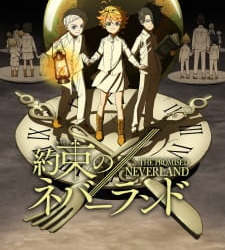
Synopsis: Surrounded by a forest and a gated entrance, the Grace Field House is inhabited by orphans happily living together as one big family, looked after by their "Mama," Isabella. Although they are required to take tests daily, the children are free to spend their time as they see fit, usually playing outside, as long as they do not venture too far from the orphanage—a rule they are expected to follow no matter what. However, all good times must come to an end, as every few months, a child is adopted and sent to live with their new family... never to be heard from again. However, the three oldest siblings have their suspicions about what is actually happening at the orphanage, and they are about to discover the cruel fate that awaits the children living at Grace Field, including the twisted nature of their beloved Mama. [Written by MAL Rewrite]
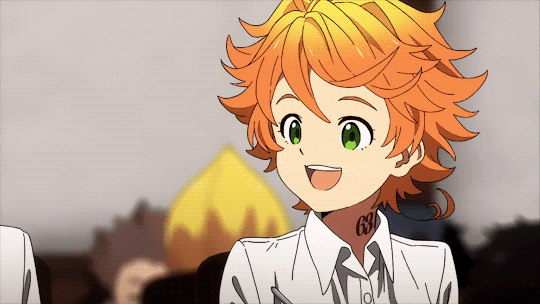
My Rating: 8.5/10
Finished airing in 2019 with a total of 12 episodes.
My Thoughts: An intriguing premise with interesting characters and nice art. Plus I just love when things suddenly take a disturbing turn... as long as it’s done well and not just played for straight up shock value. Looking forward to the next season.
Yamada-kun to 7-nin no Majo (Yamada-kun and the Seven Witches):
Genres: Harem, Mystery, Comedy, Supernatural, Romance, School, Shounen

Synopsis: When Ryuu Yamada entered high school, he wanted to turn over a new leaf and lead a productive school life. That's why he chose to attend Suzaku High, where no one would know of his violent delinquent reputation. However, much to Ryuu's dismay, he is soon bored; now a second year, Ryuu has reverted to his old ways—lazy with abysmal grades and always getting into fights. One day, back from yet another office visit, Ryuu encounters Urara Shiraishi, a beautiful honors student. A misstep causes them both to tumble down the stairs, ending in an accidental kiss! The pair discover they can switch bodies with a kiss: an ability which will prove to be both convenient and troublesome. Learning of their new power, Toranosuke Miyamura, a student council officer and the single member of the Supernatural Studies Club, recruits them for the club. Soon joined by Miyabi Itou, an eccentric interested in all things supernatural, the group unearths the legend of the Seven Witches of Suzaku High, seven female students who have obtained different powers activated by a kiss. The Supernatural Studies Club embarks on its first quest: to find the identities of all the witches.
[Written by MAL Rewrite]

My Rating: 7/10
Finished airing in 2015 with a total of 12 episodes.
My Thoughts: Pretty girls everywhere and a few pretty guys. Loved the opening and the dreamy sort of art. The art throughout wasn’t bad either. Wasn’t overly impressed with the anime itself but certainly didn’t hate it. Also has an OVA for those interested.
Yamato Nadeshiko Shichihenge:
Genres: Comedy, Shoujo

Synopsis: Ever since her crush rejected her by insulting her appearance, Sunako Nakahara has been a shut-in with a hatred for beauty, embracing all things morbid and occult-related. She is sent to live in her aunt's mansion which, to her dismay, she'll share with four exceedingly handsome boys her age. Furthermore, her flighty aunt has made a deal with these boys that in exchange for living there rent-free, they are to turn Sunako into a proper lady by the time she returns from a trip around the world. Thus begins Sunako's hectic life with abrasive Kyohei Takano, ladies' man Ranmaru Morii, calm Takenaga Oda, and friendly Yukinojo Toyama. As she interacts with them she finds them less obnoxious, and she may not be as much of an outcast as she thought. [Written by MAL Rewrite]

My Rating: 10/10
Finished airing in 2007 with a total of 25 episodes.
My Thoughts: One of the very first animes I watched and I absolutely loved it. The style, the atmosphere, the comedy, the characters, all of it!
Yuri!!! On Ice:
Genres: Comedy, Sports

Synopsis: Reeling from his crushing defeat at the Grand Prix Finale, Yuuri Katsuki, once Japan's most promising figure skater, returns to his family home to assess his options for the future. At age 23, Yuuri's window for success in skating is closing rapidly, and his love of pork cutlets and aptitude for gaining weight are not helping either. However, Yuuri finds himself in the spotlight when a video of him performing a routine previously executed by five-time world champion, Victor Nikiforov, suddenly goes viral. In fact, Victor himself abruptly appears at Yuuri's house and offers to be his mentor. As one of his biggest fans, Yuuri eagerly accepts, kicking off his journey to make it back onto the world stage. But the competition is fierce, as the rising star from Russia, Yuri Plisetsky, is relentlessly determined to defeat Yuuri and win back Victor's tutelage.
[Written by MAL Rewrite]

My Rating: 9/10
Finished airing in 2016 with a total of 12 episodes.
My Thoughts: The series that spawned a million pieces of fan art, fiction and merchandise. The figure skating anime.... who hasn’t heard of this one. Pretty enjoyable series in my opinion with an excellent opening and lovable characters. Too short though.
#my teen romantic comedy snafu#anime#the promised neverland#yamada-kun to 7-nin no majo#yamada-kun and the seven witches#yamato nadeshiko shichi henge#Yuri!!! on ice
7 notes
·
View notes
Text
Love so Life 53-60

Çevrim içi okuma:
53.Bölüm 54.Bölüm 55.Bölüm 56.Bölüm
57.Bölüm 58.Bölüm 59.Bölüm 60.Bölüm
İndirme:
53.Bölüm 54.Bölüm 55.Bölüm 56.Bölüm
57.Bölüm 58.Bölüm 59.Bölüm 60.Bölüm
#Love So Life#akane-chan and aoi-kun#kouichi kaede#shichi go san#kawai twins#matsunaga and shiharu#tumitutscanlation#türkçemanga
8 notes
·
View notes
Photo




JAPANESE DORAMA QUICK REVIEW/NOTES
I have done the movies list before and now I feel like how about the doramas hehe well anyway as always these are all my opinions, we all have different opinions so don’t take this too seriously. Doing this 4 dorama per post just like before with the movies.
Here we go~
SAIKOU NO JINSEI NO OWARIKATA | RATING: 8/10
- A family who runs a funeral never imagined someone would actually make a dorama with that in mind - This is a nice family dorama and a moving on or letting go of loved ones that passed away kind of story
SHINIGAMI-KUN | RATING: 9/10
- AKUMAAAAAAA-KUUUUUN, I WANTED AKUMA-KUN TO TAKE MY SOUL - It’s a simple story, kind of twisting your morals sometimes but nothing too much - There were cases that are really touching that made me teary eyed
TEEN COURT | RATING: 8/10
- This was nice, I think Seto Koji and Ayame Gouriki looked good together. - I like how there are various cases. This was just like your usual law themed dorama but the difference was it focused on juvenile cases.
YAMATO NADESHIKO SHICHI HENGE | RATING: 8/10
- Up to this year 2018 the skull kiss at the ending I still love that - I think it was a decent live action adaptation - The cast was great too no one else could be Yuki besides Tego
>>>Check this tag for the movies and this one for the dorama
#jpndoramareview#Saikou no Jinsei no Owarikata~Ending Planner~#shinigami-kun#teen court#yamato nadeshiko shichi henge#dorama#japanese#live action
2 notes
·
View notes
Note
At Koko and Inupi "wedding"
Akane: i could tell you the story of Koko proposing to me when he was 10
Koko: *buries his face in his hands* Not again! *soft sigh*
Inupi: *tries to not laugh*
Everyone: *laugh*
Akane: but i have a cuter story
Koko: ????
Inupi: ???
Akane: It was when they were still in kindergarten. They were so cute then. Hajime-kun called Seishu "Sei-chan" and my brother called him "Haji-chan"
Everyone: awww =)
Koko: ….Haji-chan….
Inupi: Aww. Our first nicknames =)
Akane: Well it was not for long, they switch to Seishu and Hajime for few months and then to Inupi and Koko when they started school.
Akane: But anyway, the story starts when they were 6. I was 12 then and i was reading them a cute story.
Akane: And then, i come to the point of the story where the characters marry
Akane: and Hajime-Kun jumped on his feet and said "i'm going to marry Seishu!" with the most adorable and serious face EVER.
Koko:
Inupi: *snickers*
Koko: *blushing intensities*
Akane: And Seishu blushed and said "but we can't marry, we're too young"
Akane: and then Hajime-kun said "then we gonna be engaged!"
Koko: please kill me
Inupi: aww =) i'm so so flattered Haji-chan ~
Akane: And then they wanted to do a ceremony of engagement!
Akane: I used my old Shichi-Go-San kimono (for my 7 years) to dress Seishu and i have given one of Seishu kimonot to Hajime. Seishu had mi long hair when he was little, so i brushed it. They were so cute.
Inupi: so we were really engaged Haji-chan ~
Koko: *face against the table* killl meeee
Everyone: awww
Akane: I have photos. they will pass to the photos projection about them later =)
Everyone: yeah =)
Koko: i need to escape
Inupi: No =)
Akane: Hajime-kun was so adorably serious!!
Akane: he promised me that he would always protect Seishu!! And that Seishu would never be sad with him! And then kill Seishu on his cheek. I think that i had never took so much photos before.
Everyone: Adorable =)
Koko:
Inupi: no Koko we can't go out of your own wedding
Koko: =(
Akane: But Hajime kun, how have you been able to cheat over your fiance, by propose to me 5 years later? By promising me that you'll protect me like you had promised to me to protect Seishu few years before. So cruel Hajime-kun ~
Everyone: *laugh*
Koko: *whines*
Inupi: *really tries to not laugh and pats Koko's back gently* that's alright Hajime, I love you!!
ahaha Akane in her ultimate troll big sister form is something absolutely amazing!
Koko really has this habit to always confess to people from a very young age lol
I love Akane just embarrasses her cute brother in law in front of everyone, she's perfect <3 and Inupi is having so much fun lol
15 notes
·
View notes
Text
Asian dramas and movies
A list of the dramas, movies and shows that I have watched.
Hanazakari no Kimitachi e
Hanazakari no Kimitachi e SP
Hanamizuki
One Litre of Tears
One Litre of Tears movie
Tantei Gakuen Q live action
Detective Conan live action movie 1
Detective Conan live action movie 2
Detective Conan live action movie 3
Great Detective Conan: Challenge To Shinichi Kudo
I Love My Younger Sister live action
Yamato Nadeshiko Shichi Henge
Gokusen
Gokusen 2
Gokusen 3
Gokusen movie
Death Note
Death Note 2: The Last Name
Death Note 3: L Change The World
14 Sai no Haha
Koukou Debut
Kurosagi
Nodame Cantabile live action
Nodame Cantabile SP
Lovely Complex live action
Hana Yori Dango
Hana Yori Dango 2
Kimi ni Todoke live action
I Give My First Love To You
Koizora
Atashinchi no Danshi
Ju On
Ju On 2
Ju On 3
Prince of Tennis live action
Ikemen Desu Ne
Ouran High School Host Club live action series
Ouran High School Host Club live action movie
Paradise Kiss
Zenkai Girl
Nobuta wo Produce
Akihabara@Deep
Bloody Monday
Bloody Monday 2
Honey and Clover
Kimi wa Petto
Propose Kyoudai
Pink no Idenshi
Stand Up!
Yukan Club (not yet done)
Ring 1
Ring 2
Ring 3
Ring 0
Zatoichi
Spring Story
Buzzer Beat
The Victim
Crazy Little Thing Called Love
Friendship
Brown Sugar Macchiato
Bull Fighting
Devil Beside You
Why, Why Love
Hi My Sweetheart
Fated To Love You
Hot Shot
Corner With Love/Love At The Corner
Meteor Garden
Meteor Garden 2
Meteor Rain
My MVP Valentine
Frog Prince
Silence
Love Storm
Dolphin Bay
Lavender
Full House
Dream High
Shining Inheritance
Heartstrings/You’ve Fallen For Me
Secret Garden
Playful Kiss
Love of The Condor Heroes
All About Eve
Irene
Attic Cat
Endless Love 1: Autumn In My Heart
Endless Love 2: Winter Sonata
Endless Love 3: Summer Scent
Coffee Prince
Jang Geum
Dal Ja’s Spring
My Sassy Girl, Choon-Hyang
Love Truly/Really Really Like You
Stairway To Heaven
My Name Is Kim Sam Soon
Love Story In Harvard
Attack On The Pin-Up Boys
Temptation of Wife
200 Pounds Beauty
100 Days With Mr. Arrogant
Jenny and Juno
Virgin Snow
Windstruck
Flower Boy Ramyun Shop
Jewel In The Palace
Robot
Three Idiots
Shutter
Ruk Man Yai Mak (Love Julinsee - Love at 4 Size)
Suck Seed
Yes or No
Hormones: The Confusing Teens
Seasons Change
Sunny
You Are My Pet
The Girl Who Leapt Through Time live action
Samurai High School
City Hunter
IRIS
Dream High 2
Shut Up Flower Boy Band
Blind
Skip Beat
Spellbound/Chilling Romance
Bokura ga Ita: Zenpen
Bokura ga Ita: Kouhen
To The Beautiful You
Panda and Hedgehog
You’re Beautiful
Mirai Nikki Live Action
A Gentleman’s Dignity
Phobia/4bia
Rich Man, Poor Woman
Turn Left, Turn Right
5 Prang
Seducing Mr. Perfect
A Good Day To Have An Affair
Sad Movie
Ghajini
Reply 1997
Rurouni Kenshin
Rooftop Prince
My Little Bride
Code Blue Season 1
Risou no Musuko
ATM Error
IRIS 2
Himitsu no Akko-chan
School 2013
The Naked Kitchen
Hana Kimi Remake
Jackal Is Coming
Love On That Day
Level 7/7th Grade Civil Servant
Last Cinderella
Kyou, Koi wo Hajimemashite
Pee Mak Phra Kanong
Yamada-kun to Nananin no Majo
Just One Second
Summer Nude
Reply 1994
Queen In Hyun’s Man
The Heirs
Marry Him If You Dare
Emergency Couple
Rough Play
No Breathing
The Commitment
Angel Eyes
It’s Okay, That’s Love
Birth of A Beauty
Fall In Love With Me
Master’s Sun
The Three Musketeers
The Pirates
Blue Spring Ride
You Are The Apple Of My Eye
Kyoto Inferno
The Legend Ends
Pinocchio
Ex-Girlfriend’s Club
School 2015
School 2017
While You Were Sleeping
My Secret Romance
Love O2O
Because This Is My First Life
Fight For My Way
Second Love
Baby and Me
The Outlaws
Midnight Runners
Bad Genius
Your Lie In April
Haruta and Chika
Reply 1988
Descendants of The Sun
Let’s Fight Ghost
Confession of Murder
Tokyo Ghoul live action
Code Blue 2
Code Blue 3
Along With The Gods: The Two Worlds
Along With The Gods: Last 49 Days
Radio Romance
Hormones 2
Hormones: The Final Season
A Love So Beautiful
Ajin: Demi-human
Crash Landing On You
What’s Wrong With Secretary Kim
Extreme Job
Parasite
Kingdom Season 1
Kingdom Season 2
Doctor Romantic Season 1
Goblin
Touch Your Heart
Her Private Life
Weightlifting Fairy Kim Bok Joo
Strong Girl Do Bong-soon
Love Alarm
My First First Love
I Am Not A Robot
My ID Is Gangnam Beauty
The Girl Who Sees Scent
Hotel Del Luna
Remember
U-Prince Series
A Korean Odyssey
The Package
Doctor Romantic 2
The Prince of Tennis 2019
Start-Up
Ordinary People
Itaewon Class
Hi Bye, Mama!
The Divine Fury
Back To The 90s
The Dude In Me
Put Your Head On My Shoulder
The K2
Hyde, Jekyll, Me
She Was Pretty
He Is Psychometric
Sky Castle
My Annoying Brother
Scarlet Heart: Ryeo
Find Yourself
Good Morning Call
Love In The Moonlight
Hospital Playlist
Kkondae Intern
The World Of The Married
Sotus
Was It Love?
It’s Okay Not To Be Okay
Who Are You 2020
Love Lasts Forever
Empress Ki
The Uncanny Counter
Run On
True Beauty
Sweet Home
Lovestruck In The City
A Love So Beautiful (2020)
18 Again
The Con-Heartist
My God!! Father
Space Sweepers
On Your Wedding Day
The Yin-Yang Master: Dream of Eternity
L <3 DK
How To Be Thirty
Seobok
Forgotten
Vincenzo
Confidential Assignment
Mr. Queen
Hometown Chachacha
Hospital Playlist 2
D.P.
Squid Game
Police University
Kingdom: Ashin of the North
Cheer Up, Mr. Lee
Sweet and Sour
Death Note: Light Up The New World
Orange
Prison Playbook
Oh My Ladylord
Law School
Sell Your Haunted House
Alice in Borderland
Still 2gether
Move to Heaven
My Name
Our Beloved Summer
The Door Into Summer
Bad and Crazy
AI Love You
Love and Leashes
Thirty-Nine
Twenty Five, Twenty One
Forecasting Love and Weather
Juvenile Justice
Business Proposal
My Father is Strange
61 notes
·
View notes
Text
Shinki Names. Part 1
I should probably add a disclaimer that I don't know Japanese. I did spend a lot of time looking up all the kanji though and also consulted someone who does know some Japanese
»»»»»»»»»»»»»»»»»»»»»»»»»»»»»»»»
A name is one the most important things a human can have. In ancient times, it was used to separate humans from nature, to guard them from evil spirits. Nowadays it’s more of a necessity, a primary part of one’s identity; a person without a name virtually doesn’t exist in the society.
In Noragami names, their meanings and functions are key elements of the magic universe created by Adachitoka. This two-parter is devoted to one of the name groups present in the manga – those belonging to shinki.
General rules of forming
Since shinki names are a part of Noragami’s magic system, there are certain rules for making them up. Many (if not most) of the readers of this post must already know those rules but I’ll list them just in case.
1. A shinki’s name is always (well, almost always, but we’ll get to that in Part 2) is written using a single kanji – a character that came into Japanese from Chinese. A kanji can have several meanings, one of which is chosen to be the name. The meaning’s two respective readings become two shinki names: kun-yomi, or Japanese native reading, refers to a shinki as a person while on-yomi, or Chinese sound reading, refers to their instrument name.
2. Even though shinki names are represented on their bodies by a single kanji, the kanji reading isn’t generally used as a name on its own. Another kanji is added to the kanji forming a shinki’s personal name to make yobina, which is the name a god uses when referring to their shinki in everyday life. Generally it’s a kanji that the gods use towards all of their shinki, i.e. their family/clan name. Here are examples of family names in Noragami:
音 – “ne”, Yato’s shinki’s family name. Means “sound”.
喩 – «yu», Tenjin’s shinki’s family name. Means “metaphor”.
大 – «dai», Kofuku’s shinki’s family name. Means “great”. The only prefix in this list.
麻 – «ma», Bishamon’s shinki’s former family name. Means “flax”.
巴 – «ha», Bishamon’s shinki’s current family name. See the meaning in the family names paragraph.
弥 – «mi», Ebisu’s shinki’s family name. When read as “mi” isn’t really a noun. One of the meanings is “more and more”.
云 – «un», Takemikazuchi’s shinki’s family name. Means “cloud”, “to talk”.
Known exceptions:
Noras: three out of four of Nora’s known names – Hiiro, Eyami, Mizuchi – do not include a family name (“chi” in “Mizuchi” isn’t actually a kanji for a family name, it’s part of kanji 螭's reading). Tenjin also refused to give Kugaha the “yu” clan name when gave him the name “Saku”;
Sakura and Nana, who aren’t noras but still have no family names;
Daikoku and Daigo – their clan name is added to their instrument name, not their name as a person
3. The instrument name also isn’t used on its own: kanji “ki” 器 (“instrument”) is added to it. As seen in the manga, characters in Noragami prefer to use “name + ki” when talking about a shinki’s instrument form.
Keeping these rules in mind, I’ve made this table that I borrowed from Wiki and expanded upon:

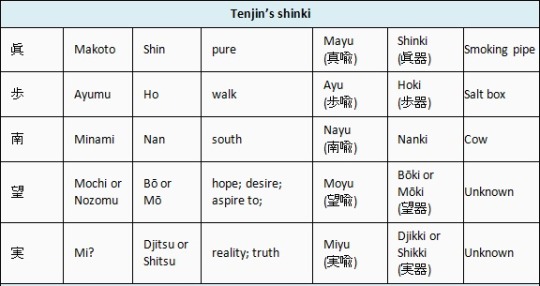
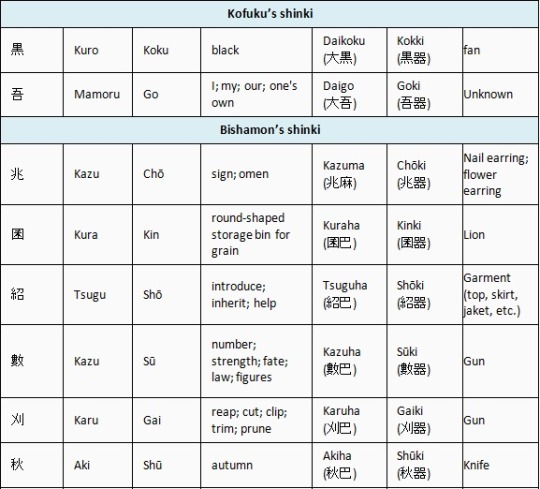

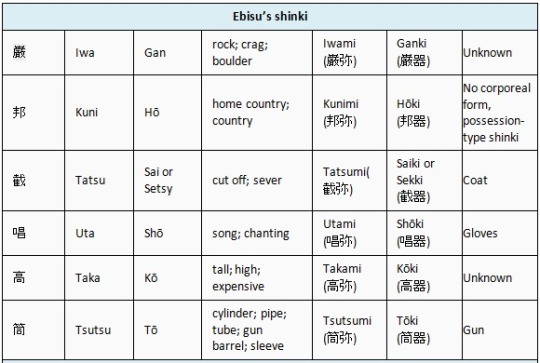

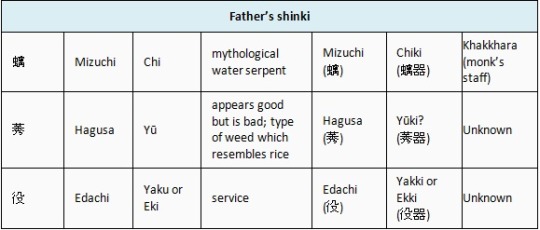
On the one hand, it seems like there’s no common theme in the names of the shinki belonging to the same god. There’s also no connection between a shinki’s name and instrument form in most cases. All in all, gods appear to name their shinki intuitively without actually thinking much about the meaning of the name. If we take Yato’s shinki as an example, three of them were named based on whatever Yato saw nearby: Yuki (snow) – it was snowing that day; Tomone (partner) – he just wished for someone to stay beside him; Sakura (sakura) – they met under a sakura tree. Momo has got a name that actually corresponds to his instrumet form – 100-yen store scissors; Hiiro’s (scarlet) and Kazune’s (calendar) seem to be a little more symbolical. Father, on the other hand, seems to be the only one to choose the names of his shinki deliberately. He gave Mizuchi the name of the monster that she turns into as an ayakashi; Edachi is literally his “servant”; and now he has Hagusa as well, “something that appears good, but isn’t”.
On the other hand, everything is not as simple as it seems. For example, look at these two translation notes about Nana’s name (Volume 16):


Moreover, “shi” means “death” in Japanese. Anything that sounds like “shi” has a connotation of “death”. A warrior is also “shi”. Number 4 is “shi”, number 7 is “shichi”. The Japanese mostly say 4 and 7 in kun-yomi in order to avoid saying “death” as much as possible. Bishamon, on the contrary, invites it. She is a warrior (“shi”), calling “shichi” to her service by her instrument name (on-yomi) – all of that does not bode well for any Japanese.
And here’s another example with Kiun’s name form Volume 17. When he recalls the day he was named by Take, he says that he was given “a very noble name” Ki.

Yellow is also the color of Amaterasu and her descendants, the Imperial dynasty. There are even several shades of yellow that can be used for dyeing the emperor’s clothes only.
So the reason why there’s no clear theme in the names of shinki of the same god and why they usually have nothing to do with shinki’s instrument forms is because each name has unique circumstances that surround it.
(BTW, regarding the “seven tools”: it’s a little far-fetched, but Yato technically has all of them as well. Yukine is his long sword and short sword while Kazuma is the rest – clothes (armor), bow, arrows, the scarf that also covers his head (helmet & cloak), and katana, because sure, why not).
Naming incantations
To give shinki a name, either for the first time or to someone who’s had a name before, a special incantation needs to be used.
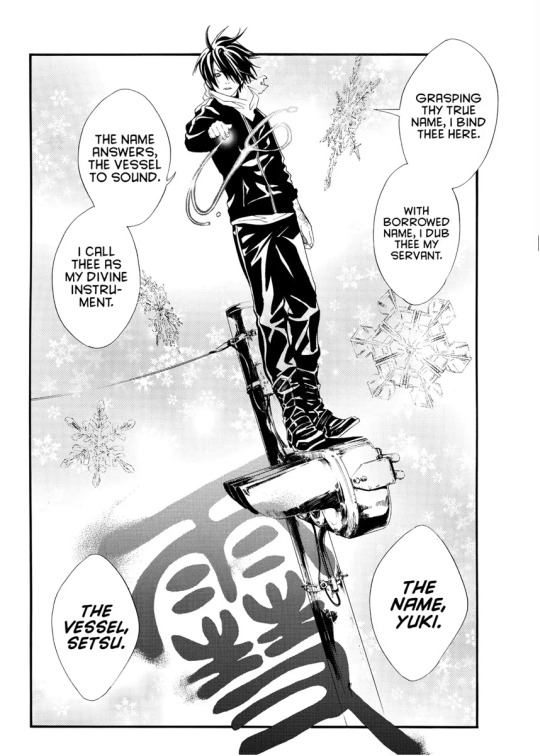
This translation note was super helpful back when I first started reading Noragami. However, it was made in Volume 1, when little to nothing was known about the significance of names in the lore of Noragami, so I’m going to update it a bit.
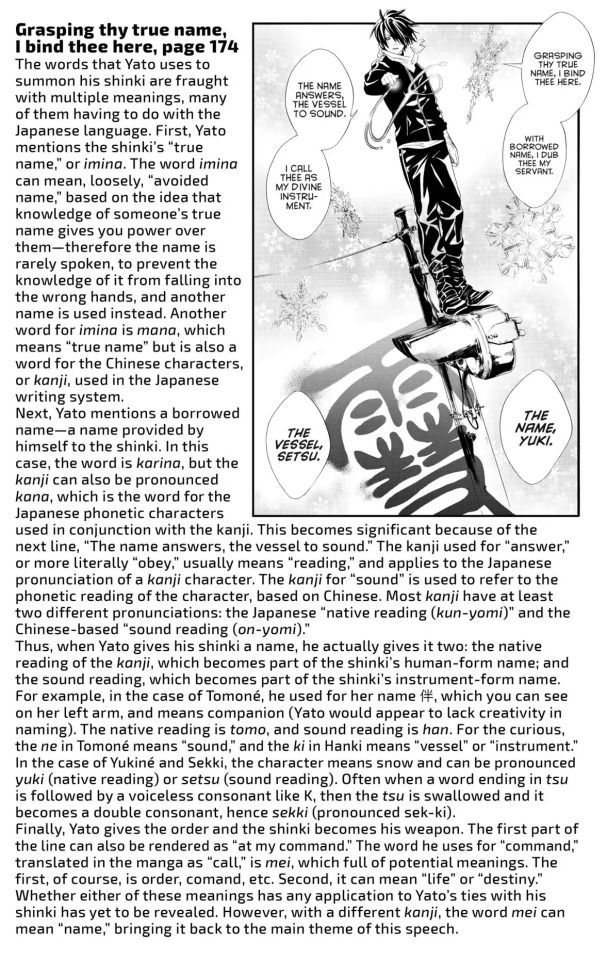
Apparently, imina is the real name of a deceased person or a noble that is changed to a posthumous name; a forbidden, avoided name. Early on, before I reached the part with the gods’ greatest secret, I assumed that imina referred to the kun-yomi reading of a shinki’s name (like Yuki for Yukine). I thought that the reason gods added a family name to the kun-yomi reading was, just like it says in this note, to avoid the repetition of that name. But then there are noras, who almost always don’t get a family name, and shinki like Sakura and Nana, who are not noras and still don’t have family names either. So imina can’t possibly be the kun-yomi reading - if it really is an “avoided name” that shouldn’t be used for any purpose other than reverting a shinki from their instrument form, surely gods wouldn’t risk using it as a yobina (the name the gods call their shinki in everyday life, like Yukine) as well? That’s why I think that the first two lines of the incantation are a literal description of how the god’s greatest secret works. The god “grasps”, i.e. learns and conceals, a deceased person’s actual name – grasping thy true name, I bind thee here – and replaces it with the name that he/she makes up for that person – with borrowed name, I dub thee my servant. Karina, or the borrowed name, is the one that seals away the true name that should never be spoken. Lines 3 and 4 are pretty much an instruction for using a shinki. And the part about “mei” meaning both “command” and “destiny”,“life” explains why the last line was translated as “I use my life to make you my servant” in the anime. Wiki says that the reason why gods and shinki have this connection that can end up killing the god is because they use their life to create shinki, and I support the notion. After all, if there’s a line or word in Noragami that has more than one meaning, it’s 99% chance that it’s intentional. The last line shows that a shinki isn’t just a servant but a huge responsibility that a god may end up paying for with their life.
There aren’t any specific conditions to be met when naming a shinki (apart from the fact that a corrupted soul can’t become one, and even that’s… debatable); a spirit can receive a name voluntarily or forcefully. With regular ghosts who get a name for the first time it’s often not consensual since they don’t even know that’s a possibility (though there’s actually a cute scene in which Yato tries to persuade an old lady spirit to become his shinki freely). A shinki who has been released before can ask another god to name them, like Sakura did. Or, they can ask for a name without being released and become a nora. Finally, a god can forcefully give a name to a shinki who’s already serving another god, which is what Tenjin did to Kugaha. This, however, doesn’t mean that a shinki is defenseless against a god who wants to name them against their will, as shown in this scene with Yato, who wanted to make Kazuma a nora “for a bit” but helped him learn how to use borderlines instead:

Another interesting detail regarding the naming incantation is that it can only be used once – a god doesn’t get to name their former shinki for a second time (chapter 72).
Apart from the naming incantation used on shinki, there’s also a similar one for ayakashi (chapter 27).

The name Ebisu gives the ayakashi is Ryōki (菱鬼).It sounds like a shinki name (Mineha’s instrument name is also Ryōki), except here “ki” means “ghost”, “demon”. The first two lines of the incantation are very similar to the one used on shinki. Which is strange if you think about it, ‘cause unlike shinki, ayakashi don’t really have a name that must be concealed. Though they are born from human emotions, and some of them are even former humans (former shinki), so maybe that’s it. The difference in the first two lines of the two incantations is that an ayakashi is also tied to a mask. And there’s an entire translation note to be made about the rest of it.
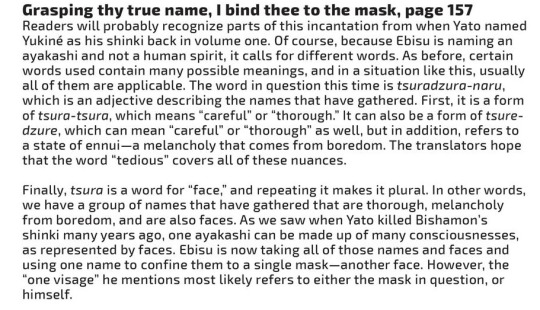
The “one visage” probably really is the god using the incantation since Ebisu seemed to get blighted by his ayakashi the way shinki sting their masters when they sin – not on a surface level but with a deep, indelible blight.
Also, an ayakashi gets only one name, not two.
Finally, there’s also a hybrid incantation Father used in chapter 84 in combination with kotonoha to give names to shinki who started turning into ayakashi.
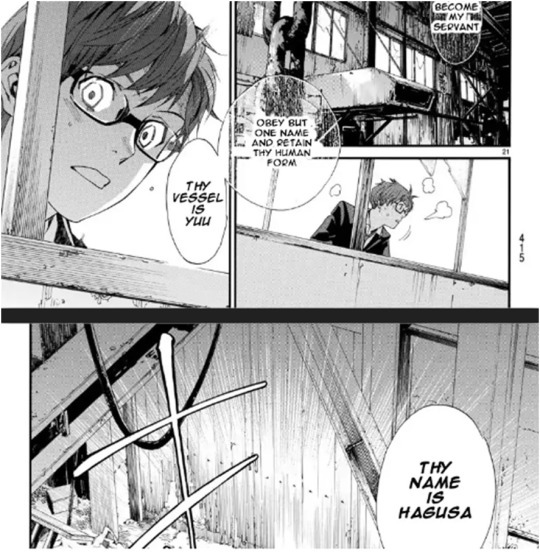
The first lines aren’t shown but they are probably the same as the ones in the regular incantation. Like any other shinki, Hagusa receives two names, as a person and as an instrument. The part resembling the incantation for naming ayakashi is the line about “obeying one name”, though with ayakashi it was “one face”. The last line is unique to this version of the incantation – using the kotonoha, Father orders Hagusa to retain his human form (in fact, we don’t know for sure if the incantation is actually necessary or if Father is simply imitating the gods while the only thing really needed for the naming is the brush).
Family names
Kazuma explains the existence of family names in chapter 18.
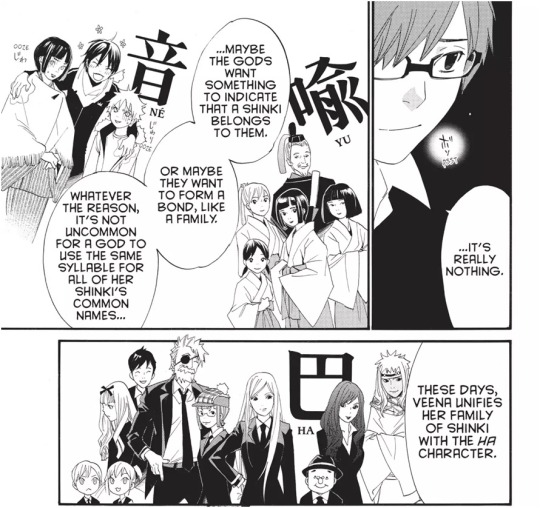
As mentioned earlier, “ne” and “yu” mean “sound” and “metaphor” respectively. The reason for the “ne” name, as we know, is very personal, while “yu” might have something to do with Tanjin being the god of learning and also a poet in his human life. Explaining the “ha” name will take a little longer.

Kazuma might think that family name is “really nothing”, but gods would clearly disagree. One of the things indicating that they don’t consider a family name “a nothing” is refusing to give one to noras. Tenjin did not give Kugaha the “yu” name when made him his nora Saku. Nora only has one name that has a family name attached to it – Tsutsumi, which she received from Ebisu. Ebisu himself is an exception though since he would name any shinki capable of drawing a borderline, so all of his shinki have the “mi” name, whether they are a nora or not. Another exception is Kazune but that is a special case since Yato and Kazuma have known each other for a long time; no wonder Yato decided to give Kazuma his family name.
Yato’s first two shinki, Sakura and Hiiro, didn’t have family names either, but that’s because Yato didn’t know he could or was supposed to give them one. Kazuma’s guess about creating a family bond through a common name is also correct – Bishamon explicitly states she doesn’t want to give Nana the “ha” name ‘cause she doesn’t want to become too attached to the girl who’s supposed to be her “disposable” weapon.
Finally, gauging the importance of a family name without knowing its backstory is hasteful. Yato’s family name “ne” simply meaning “sound” doesn’t seem to be very important at first. But to Yato it’s more than just a sound:

And Bishamon had a similar reason for not giving Kazuma the “ha” name after the Ma clan was wiped out.
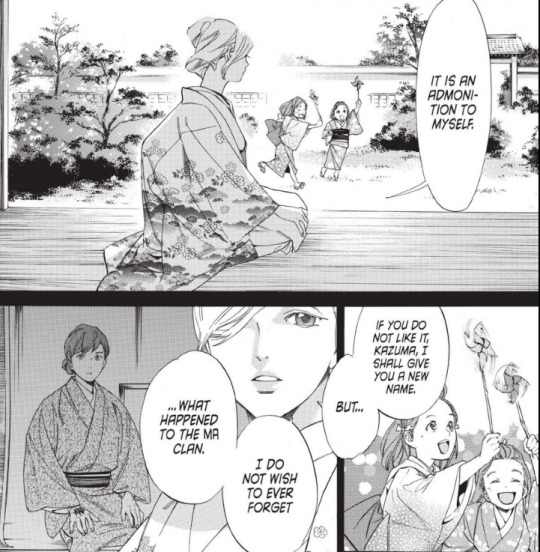
This makes the names Father gives to his shinki – like Mizuchi and Edachi - all the more interesting. They sound like they have a family name “chi” but are actually written with a single kanji. So Father is basically creating an illusion of a family name that isn’t there. Another notable thing is that he did not choose a name ending with –chi for Hagusa. Does it mean that Father doesn’t want to make him a part of this “family”, however fake it is?
Summoning a shinki
To summon a shinki, all you need to do is call their instrument name. There are some nuances though. Firstly, sometimes shinki can have a delayed response, like how Yukine only answered to Yato’s call after his second attempt in chapter 26.
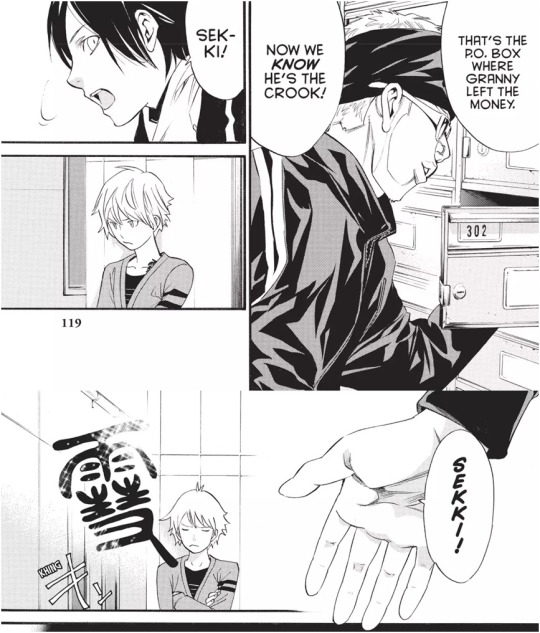
It’s hard to tell whether all shinki are capable of this. Yukine is a hafuri here, so we can’t be sure if his new status affects his ability to resist his master’s call or not. It’s also not clear if Yukine decided to help out on his own or if he couldn’t refuse his nature as an instrument after all. There are, however, other instances of shinki not coming after being summoned. Takemikazuchi’s senior shinki outright refused to respond to his call the night they killed him:
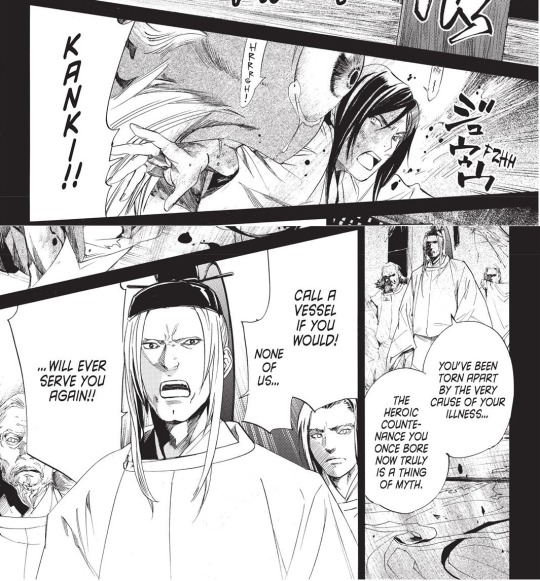
And then there’s Kiun who apparently can simply sleep through being summoned.
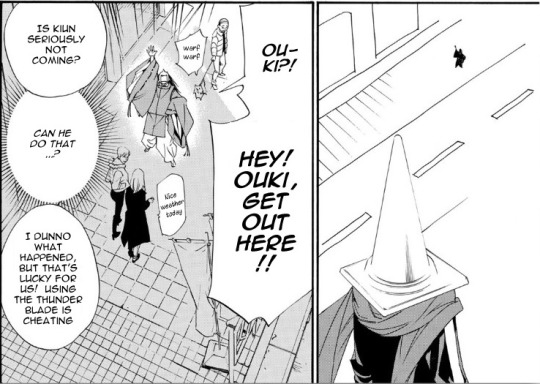

The reason why this is important is because it influences our understanding of the nature of the bond between a god and a shinki and shinki’s level of autonomy. Are shinki bound to transform because of a magical contract embodied in their name, or can they choose freely? The second option suggests a more trust-based connection between shinki and their masters. If they are able to ignore the summoning but willingly come to the gods’ aid without questioning the need to do so, it means they want to support their masters no matter what. New shinki can’t resist the call though, as seen here:
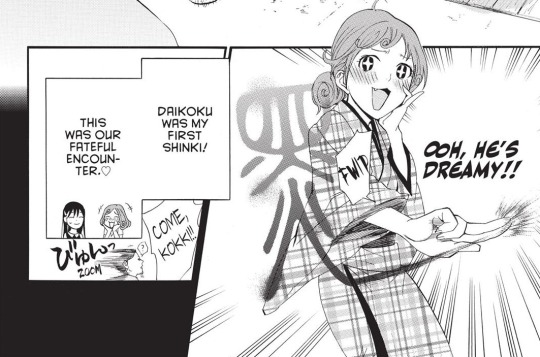
Secondly, there’s an entire group a shinki who definitely can choose whether to respond to a call or not – noras. Hiiro ignored Yato several times: when Yato and Ebisu called her at the same time, she chose Ebisu; when Yato was calling for her to fight off the masked ayakashi, she did not respond.

Noras’ ability to choose if they want to take their instrument form or not makes sense regardless of whether it’s something all shinki can do or just them. Even if they are magically bound to transform when called, in a situation with two masters summoning then at the same time they will have to do something eventually. If they can’t ignore the summoning and also can’t split into two different instruments, it makes sense that they’d be at least able to choose whose call to answer. And as for Hiiro ignoring Yato’s call in a situation where there was no need to choose, there are several different explanations here. Maybe the ability to choose is simply always present for them, even when they aren’t summoned by two gods at the same time. After all, noras are resistant to name-binding spells in general. Another explanation can be that Hiiro is a half-shinki, half-yakashi who was named using the kotonoha. If her bond with Father is stronger than with any of her other masters because of that, then no wonder ignoring Yato was so easy for her.
Another thing I’m curious about is long-distance summoning. It wasn’t a thing in the beginning of the series – Yato did not call for Sekki when Kugaha attacked him near Suzuha’s sakura tree; the seven gods of fortune didn’t even try to summon their shinki when they were under arrest by the Heaven’s guard. However, Takemikazuchi calls his shinki from Takamagahara to Earth like no big deal (well, except for Kiun, who overslept).
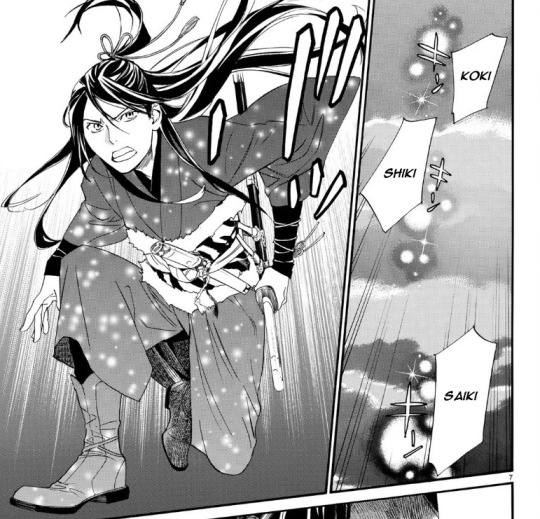
And he also expects them to appear in Takamagahara if he summons them there:

I can see two possibilities here. 1) There had to be a reason why gods didn’t try to summon their shinki in the the cases mentioned. Like Yato not wanting Yukine to find out that Suzuha was dead, or the seven gods of fortune not wanting to get their shinki into trouble with the Heavens. 2) Adachitoka didn’t think of long-distance summoning in the beginning of the series and added it later.
Finally, shinki only answer to their master. Someone else pronouncing their name as an instrument or name as a person won’t work. There’s only one exception – the ruler of Heavens, the goddess of sun Amaterasu, who knows the name of all the gods and shinki and can call them. She was able to summon Sekki to put him into the box where he was supposed to spend the rest of the eternity. She also reverted Kokki by calling his name “Kuro” when she saw how he was trying to do something on the ground.
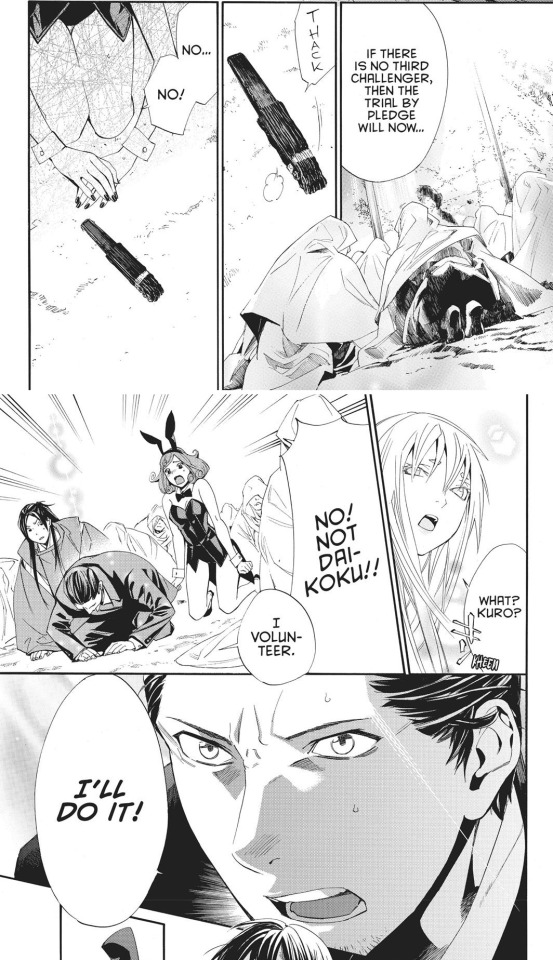
Releasing shinki from the name
Gods can release their shinki on their own will and upon request; no special incantation is needed. All a god needs to do is to write the name in the air and say that they release their shinki. After that the kanji tattooed on the shinki’s skin breaks and vanishes.

A released shinki looses their abilities (such as using borderlines) until they find themselves a new master but other than that the procedure is harmless.
However, there’s also Liberation, which breaks shinki names forcefully. Saying their original human name in the presence of a shinki or a direct question about the cause of their death leads revealing the gods’ greatest secret. That destroys their god-given name and the shinki turns into an ayakashi under the weight of all the regrets about the life they could have lived. There are only two shinki known to have survived the Liberation – Nana and Mizuchi. Mizuchi can even reveal the secret herself, although that power seems to be limited to her Chiki form.
Finally, there’s another unpleasant aspect of the lore that’s tied to releasing a shinki: if a god vanishes before taking the name from their servant, that name still remains. It’s one of the reasons some shinki end up being noras – a name no one can call is useless, so the only way to get a home and a shelter from ayakashi is to find another master. It’s not as easy as it sounds since the gods’ distaste towards noras is so strong that simply having a name given by another god is a reason enough not to take in an abandoned shinki.

Conclusion
I think it’s brilliant – to use the linguistic peculiarities of the Japanese language to form this unbelievably interesting and probably one the most memorable aspects of the magic system. I’m even more amazed at how much significance it has for the plot and characterization of the manga’s, well, characters. This theme will probably be further developed in the series, so I can’t wait to read new chapters of Noragami to find out other secrets of shinki names that Adachitoka have in store for us.
194 notes
·
View notes
Text
Jdramas/movies I've completed in:
2007
Hana Kimi
2012
Nobuta wo Produce
Buzzer Beat
Hana Yori Dango S1
Hana Yori Dango S2
Hana Yori Dango: Final
Bokura ga Ita
Liar Game
2013
Itazura na Kiss ~ Love in Tokyo
Gokusen 1
Gokusen 2
Gokusen 3
Gokusen: The Movie
Liar Game 2
Liar Game: The Final Stage
Liar Game: Reborn
Akumu-Chan
Yamato Nadeshiko Shichi Henge
2014
High School Debut
Koizora
Kimi ni Todoke
1 Liter of Tears
Rurouni Kenshin
Paradise Kiss
2015
Kinkyori Renai
Kyo, Koi wo Hajimemasu
From 5 to 9
2016
Rich Man, Poor Woman
Itazura na Kiss 2 ~ Love in Okinawa
Itazura na Kiss 2 ~ Love in Tokyo
Kurosaki kun no Iinari ni Nante Naranai
2017
Boku, Unmei no Hito desu
The Dark Maidens
Zenkai Girl
2018
Your Lie in April
Suki na Hito ga Iru Koto
Sensei! Suki ni Natte mo Ii Desu ka?
Let's Go, Jets!
Chihayafuru Part 1
Chihayafuru Part 2
Chihayafuru Part 3
Heroine Disqualified
2019
Unnatural
Rich Man, Poor Woman: The Movie
Proposal Daisakusen
Proposal Daisakusen SP
3-Nen A-Gumi
Juuninin no Shinitai Kodomotachi
Hotaru no Hikari S1
2020
Koi wa Tsuzuku yo Doko Made mo
Iguana no Musume
Long Vacation
The Confidence Man JP
Masquerade Hotel (movie)
Switched
BG: Personal Bodyguard Season 1
BG: Personal Bodyguard Season 2
Kakegurui S1
Kakegurui S2
The Many Faces of Ito
Followers
Oyabaka Seishun Hakusho
Engine
Sunny: Our Hearts Beat Together
Asunaro Hakusho
Kyou Kara Ore Wa!!
Kyou Kara Ore Wa!! SP
Mother
Alice in Borderland
2021
Todome no Kiss
Good Doctor
Million Yen Women
The Confidence Man JP: The Movie
Kyou Kara Ore Wa!!: Gekijoban
MIU404
Shitteru Wife
The Naked Director
Remolove
Detective Conan Movie 21: The Crimson Love Letter (exception)
Detective Conan Movie 23: The Fist of Blue Sapphire (exception)
Dragon Zakura Season 1
Hana Nochi Hare
Homunculus
Rurouni Kenshin: Kyoto Inferno
Rurouni Kenshin: The Legend Ends
Rurouni Kenshin: The Final
The Naked Director S2
Dragon Zakura 2
Nigeru wa Haji da ga Yaku ni Tatsu
Uchi no Musume wa, Kareshi ga Dekinai!!
Okane no Kireme ga Koi no Hajimari
Omoi, Omoware, Furi, Furare
Gekijou
Aishu Cinderella
Watashitachi wa Douka Shiteiru
Kanojo wa Kirei datta
Tremble all You Want
Waiting for Spring
I Want to Eat your Pancreas
Detective Conan Movie 24: The Scarlet Bullet (11.2.21)
Damashie no Kiba
Tapestry/Ito
2022
Saiai - [01.17.22]
Love Like the Falling Petals [3.26.22]
Sakura [04.02.22]
5 notes
·
View notes
Text
Jun Kaname Dramas
(More or less in watching order)
Currently watching: Unubore Deka (2010) Soratobu Kouhoushitsu (2013)
Dramas watched: Kamen Rider Agito (2001) Himitsu no Hanazono (2007) Atashinchi no Danshi (2009) Kimi Hannin Janai yo ne? (2008) Katagoshi no Koibito (2007) Bokura wa Kiseki de Dekite Iru (2018) Ryusei no Kizuna (2008) Boku to Star no 99 Nichi (2011) Ashita no Kita Yoshio (2008) Juhan Shuttai! (2016) Kurofuku Monogatari (2014) Kuragehime (2018) Kiraware Matsuko no Issho (2006) Shiro demo Kuro demonai Sekai de, Panda wa Warau (2020) Taiyou no Uta (2006) Akuma no Bengonin (2019) Yami no Bansosha (2015) Zekkyou (2019) Doctor-X 7 (2021) RESCUE (2009) Hikinukiya: Headhunter no Ryugi (2019) Barairo no Seisen (2011) Jikkyosareru Otoko (2016) Hayami-san to Yobareru Hi (2012) Denchi ga Kireru Made (2004) ON Ijou Hanzai Sousakan Todo Hinako (2016) Fixer (Season 1) (2023) Iki mo Dekinai Natsu (2012) Siren (2015) Watashi no Shitai wo Sagashite Kudasai (2024) *currently rewatching
Specials & movies watched: Demo, Kekkon Shitai! ~BL Mangaka no Kojirase Konkatsuki~ (2017) Casshern (2004) Udon (2006) Akutou (2012) Liar Game: Reborn (2012) Ayashii Kanojo (2016) Over Drive (2018) Hana no Kusari (2013) Kingdom (2019) Goemon (2009) Hakujitsu no Karasu 2 (2020) Girl (2012) Tora-san (2019) Mou Yuukai Nante Shinai (2012) Sumaho o Otoshita Dake Nanoni (2018) Saigo no Kizuna (2011) Cabin Attendant Keiji: New York Satsujin Jiken (2014) Vanilla Boy: Tomorrow is Another Day (2016) Wild 7 (2011) Hotaru no Haka (2005) Destiny: Kamakura Monogatari (2017) Tantei Mitarai no Jikenbo Seiro no Umi (2016) Sakura no Yona Boku no Koibito (2022) Tsuyoki Ari (2014) Kaibutsu (2013) Ooku: Eien (2012) Toga no Hito (2017) Hayami-san to Yobareru Hi SP (2012) Pyuu to Fuku! Jaguar: The Movie (2008) Kingdom 2 (2022) Kamisama no Karute (2011) Kaettekita Ie Uru Onna (2017) Jishaku Otoko (2014) Jishaku Otoko (2015) Nazotoki wa Dinner no Ato de: Movie (2013)
Other J-Dramas
(By year order)
Currently watching: Gokusen 2 (2005) Yasashii Jikan (2005) Freeter, Ie o Kau (2010) Love Distance (2020) Watched: Gokusen (2002) Kimi wa Petto (2003) Minami-kun no Koibito (2004) Bloody Monday (2008) Tokyo DOGS (2009) Yamato Nadeshiko Shichi Henge (2010) Bloody Monday 2 (2010) Shokuzai (2012) Share House no Koibito (2013) Bitter Blood (2014) Yowakutemo Katemasu (2014) Ouroboros (2015) Black Pean (2018) Tokusatsu Gagaga (2019) Koi wa Tsuzuku yo Dokomademo (2020) MIU404 (2020) Unmei Kara Hajimaru Koi (2020) Gokushufudo (2020) Kyoufu Shinbun (2020) Nao-chan wa Shogakusannensei (2021) Koi wa Deep ni (2021) Oshi no Oujisama (2021) My Family (2022) Yangotonaki Ichizoku (2022) Vivant (2023) One Day: Seiya no kara Sawagi (2023) Black Pean 2 (2024) Informa: Yami wo Ikiru Kemonotachi (2024)
#not including unsubbed stuff#or things I've only seen 1-2 eps of#variety shows#commercials#etc#fangirl's post#I don't know why some of the text doesn't line up lol?#currently super into Nino lol#and arashi in general :>
2 notes
·
View notes